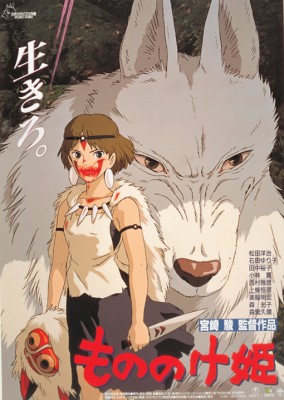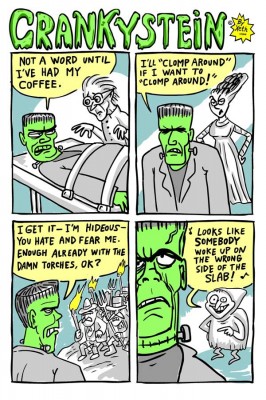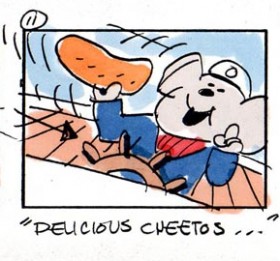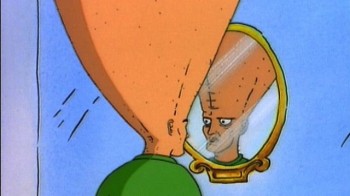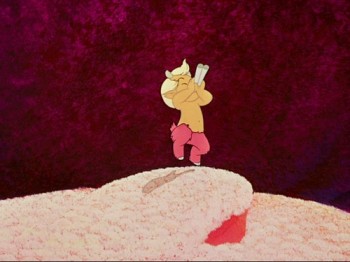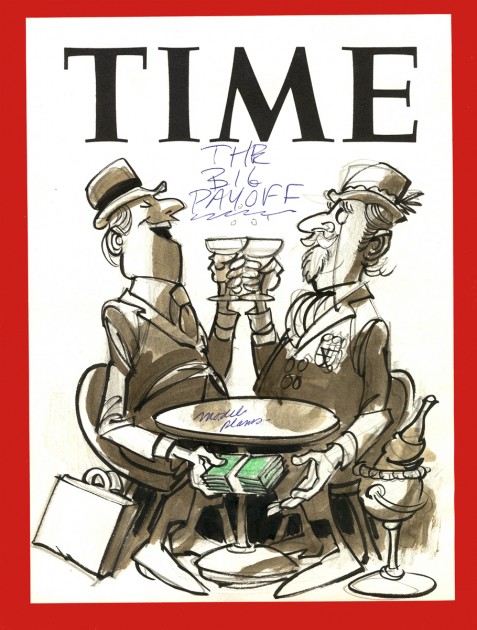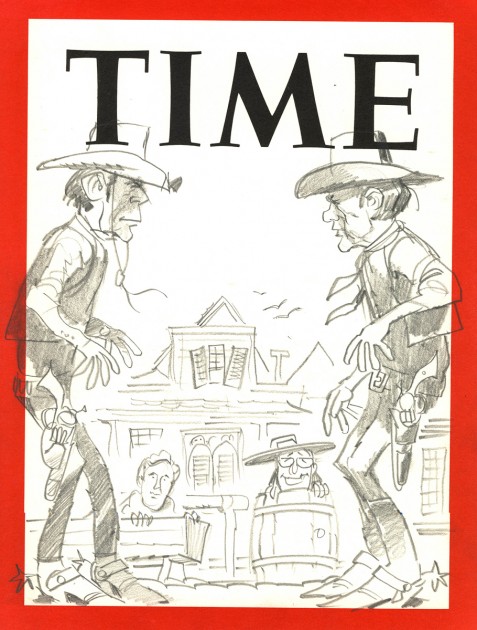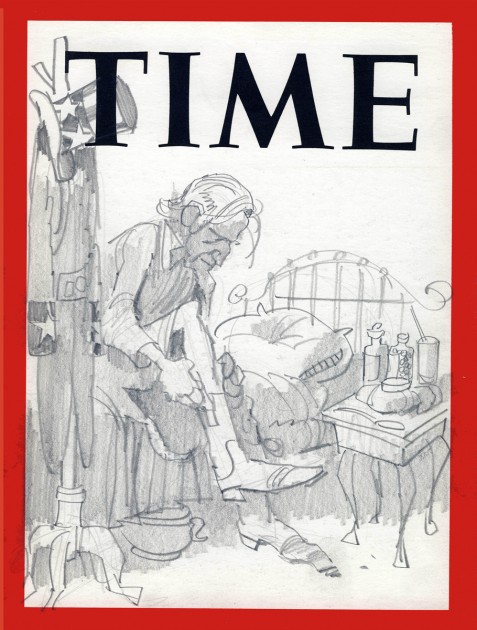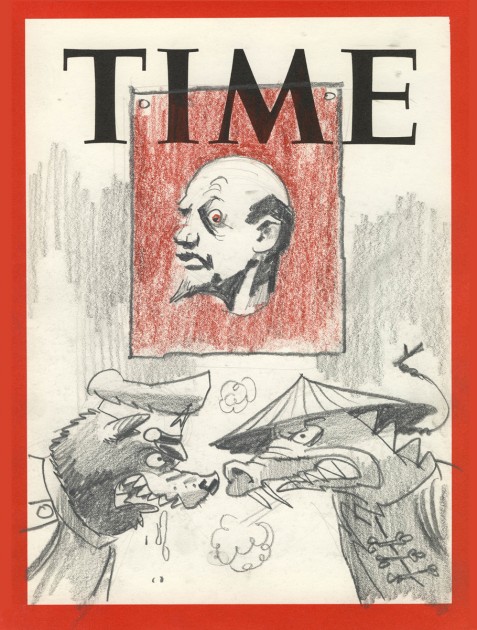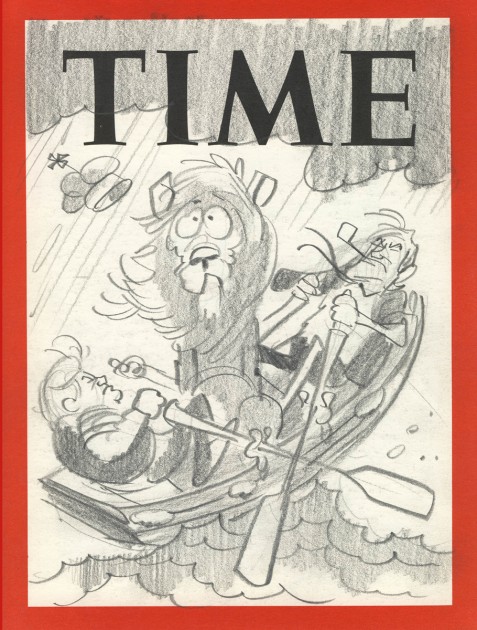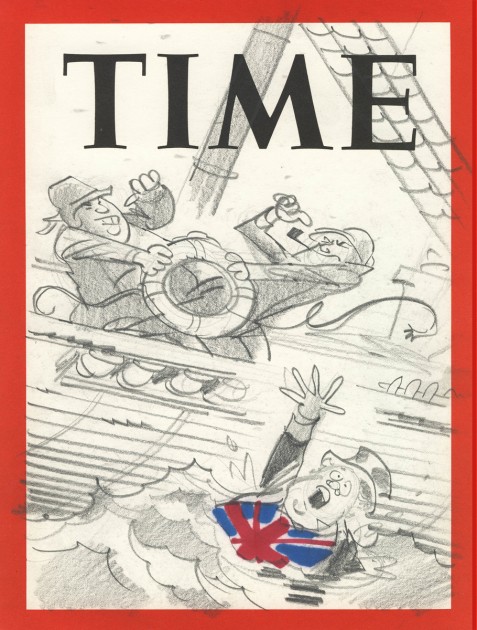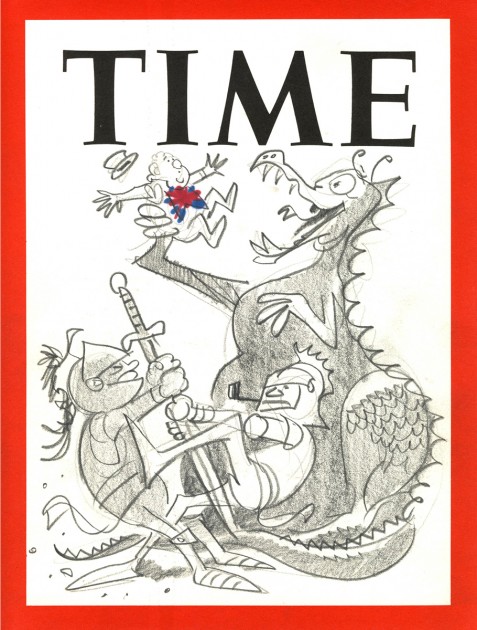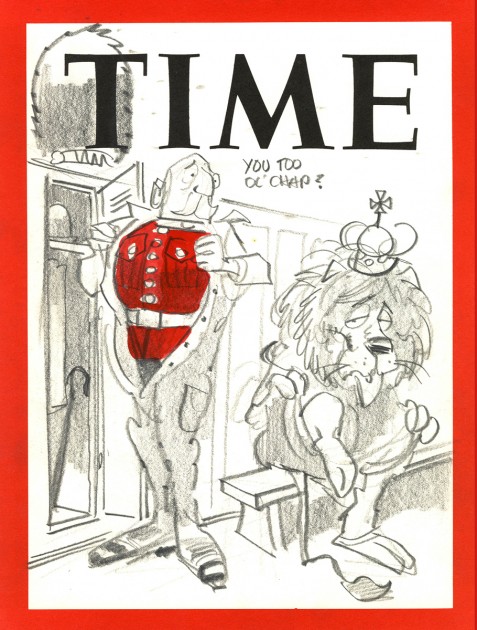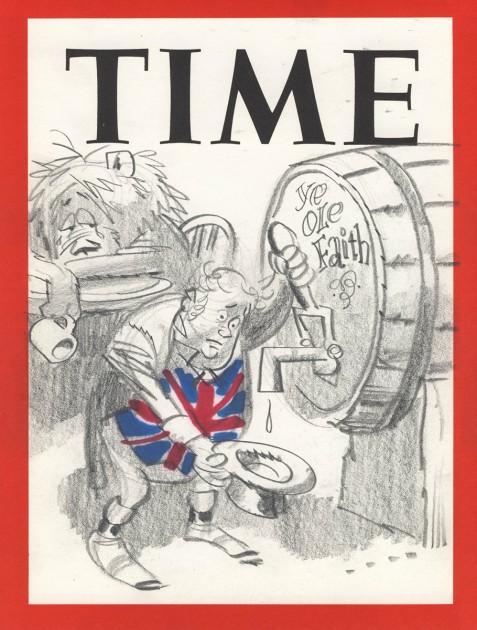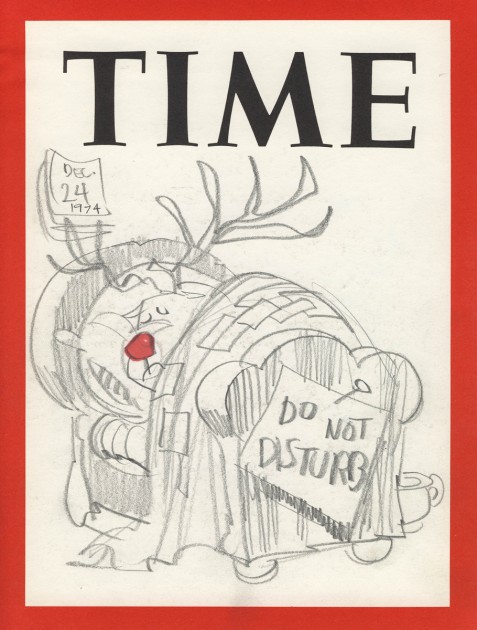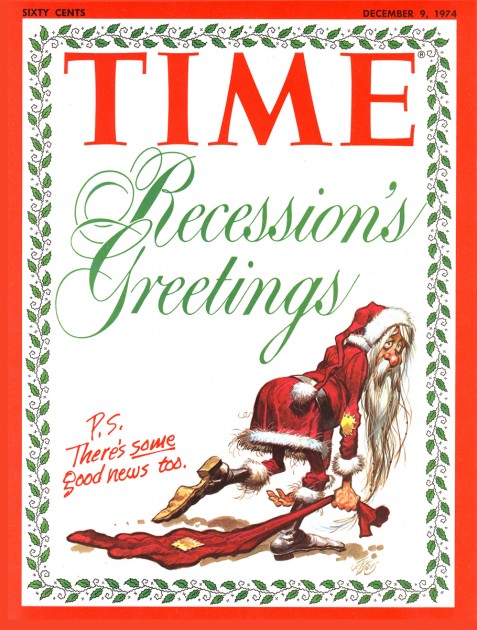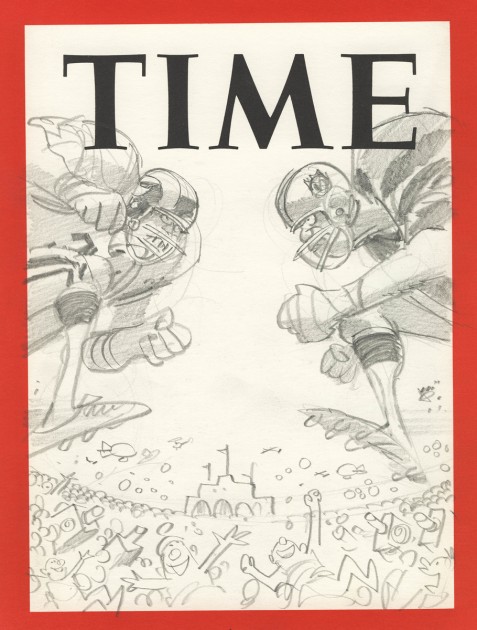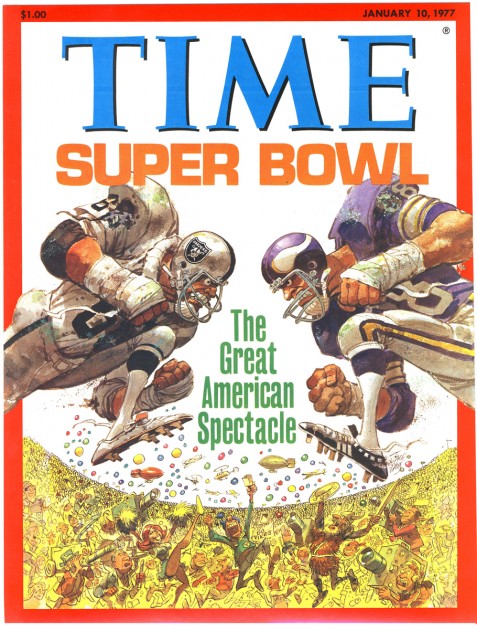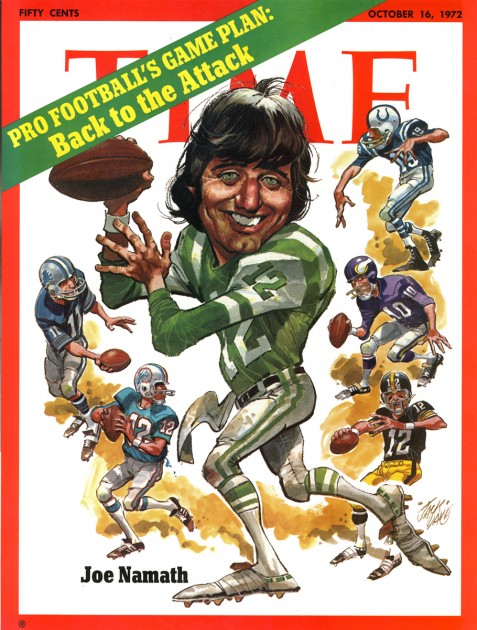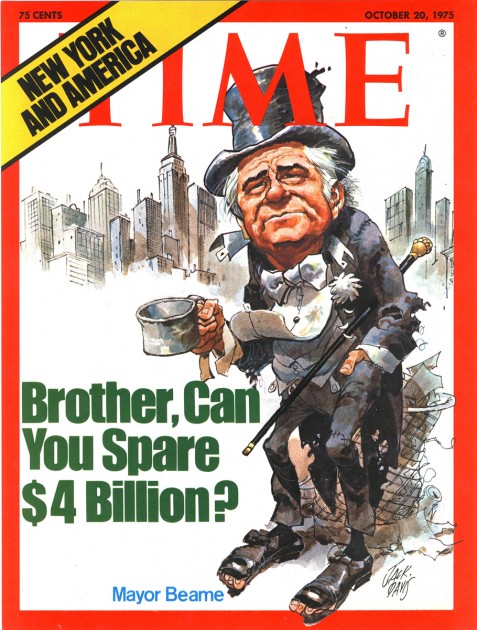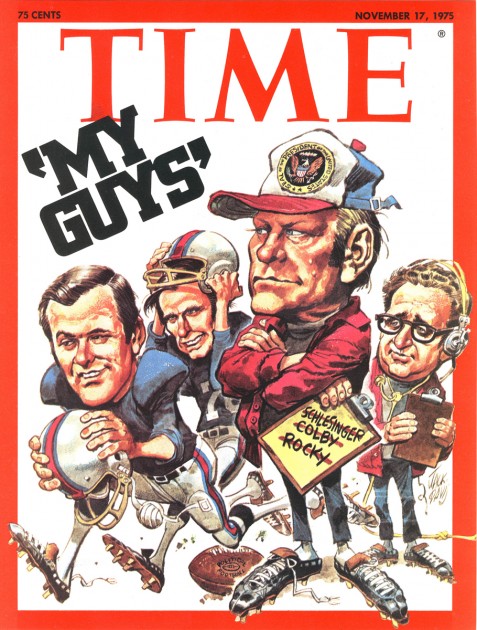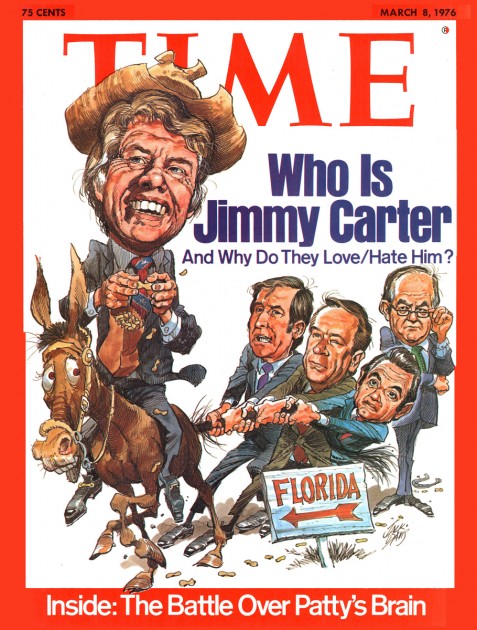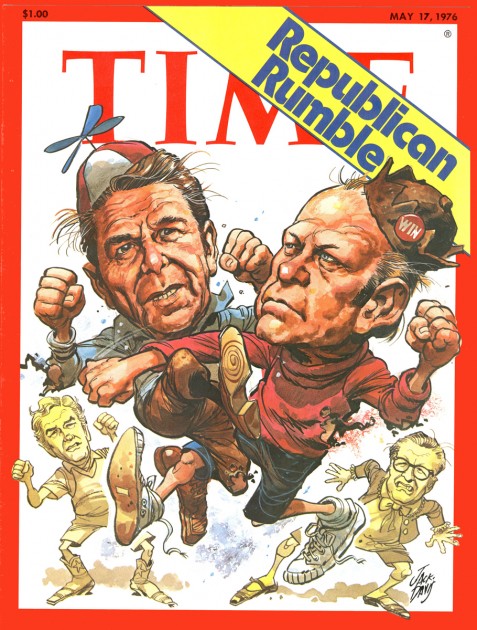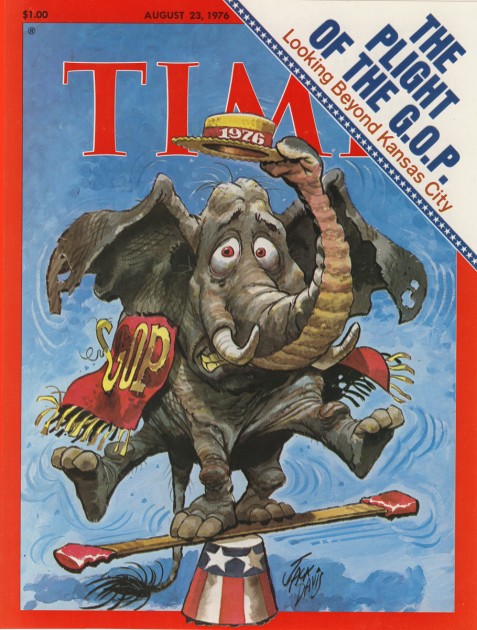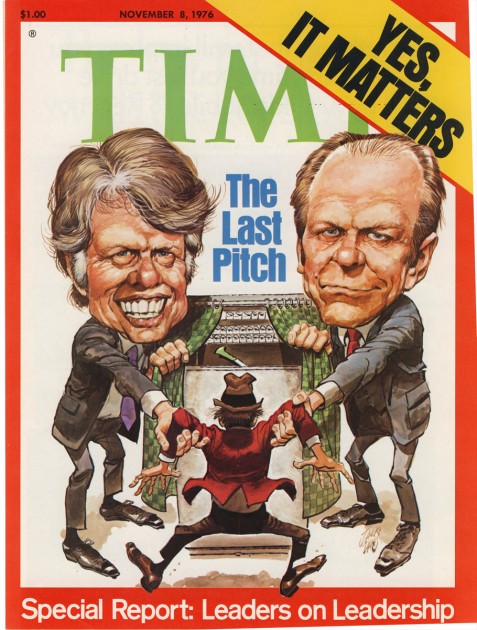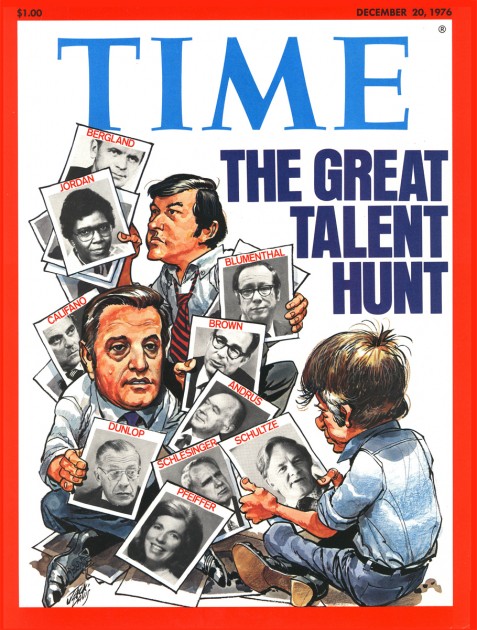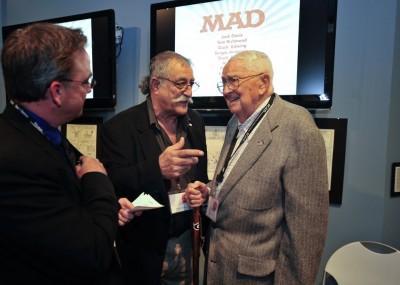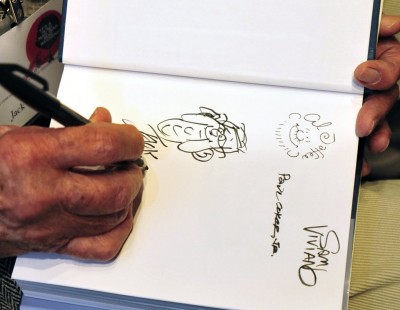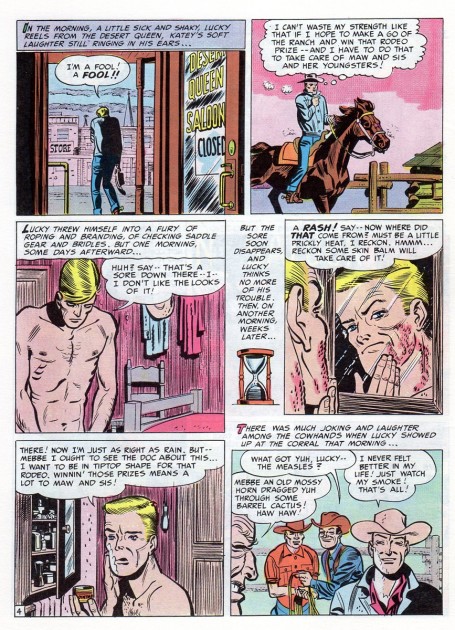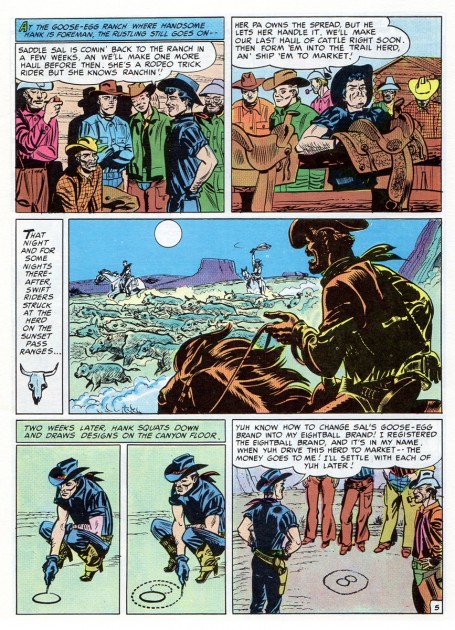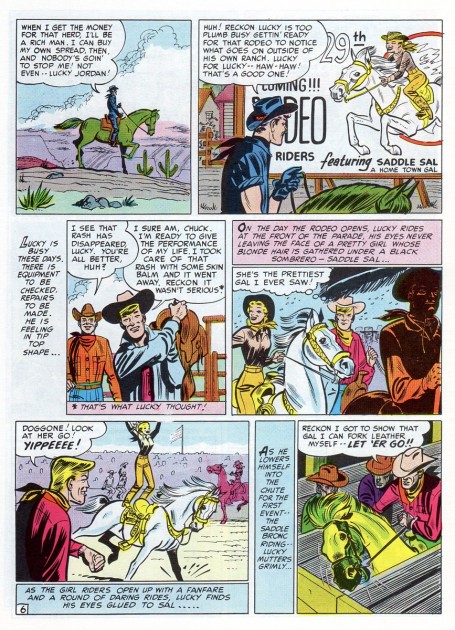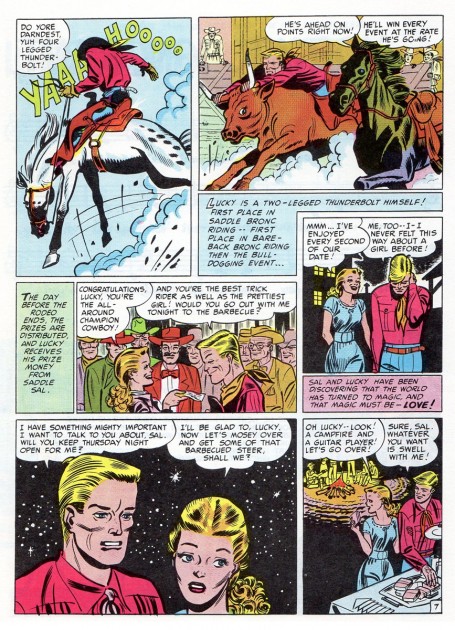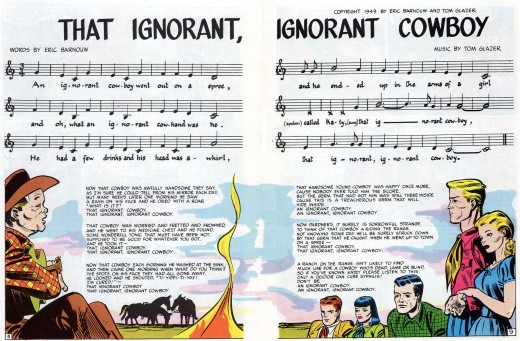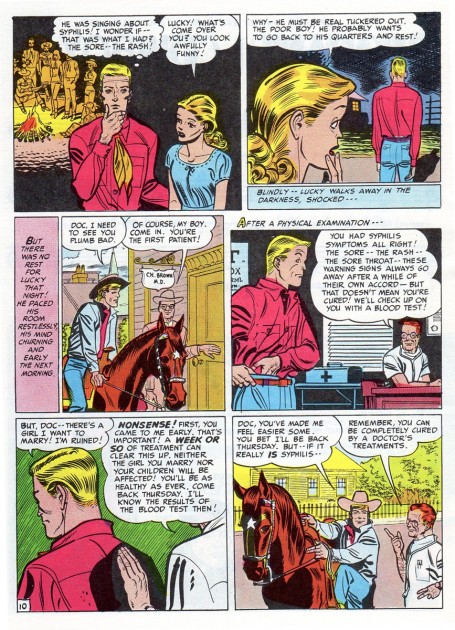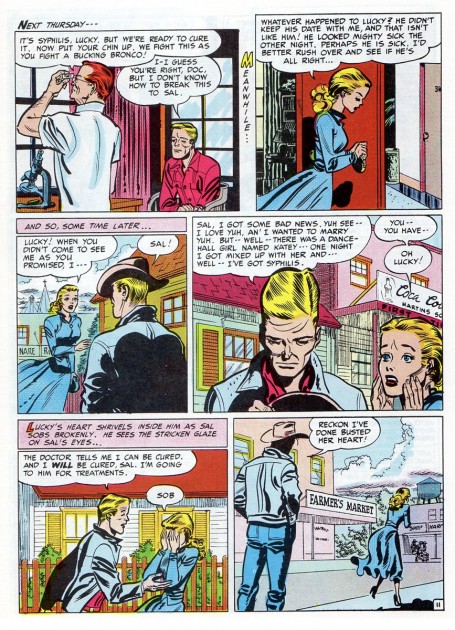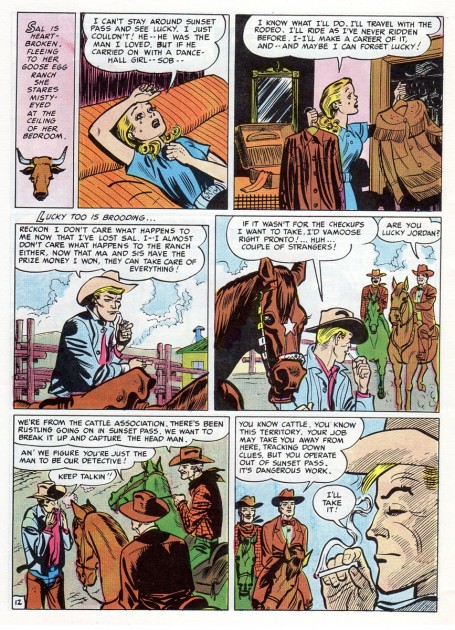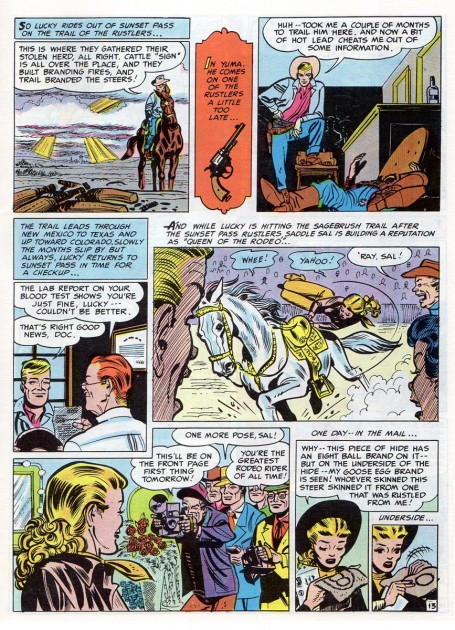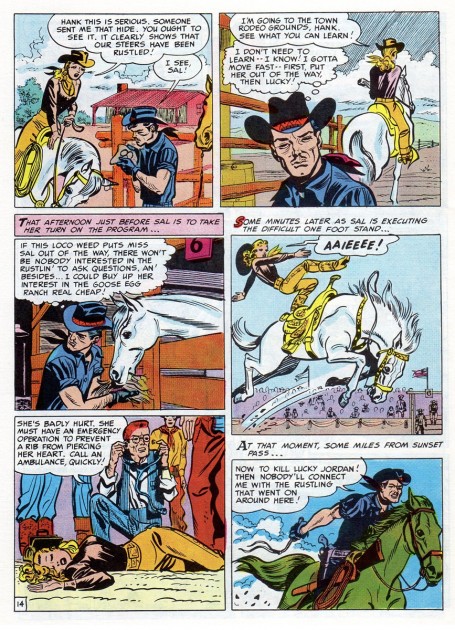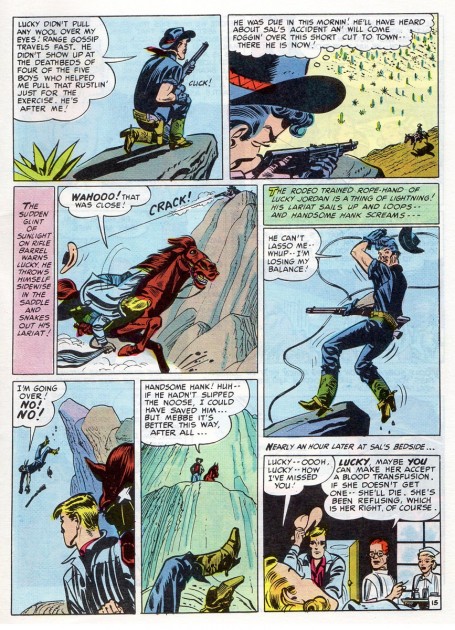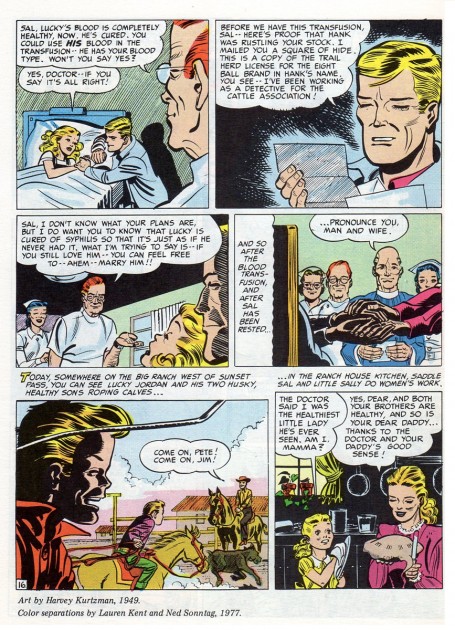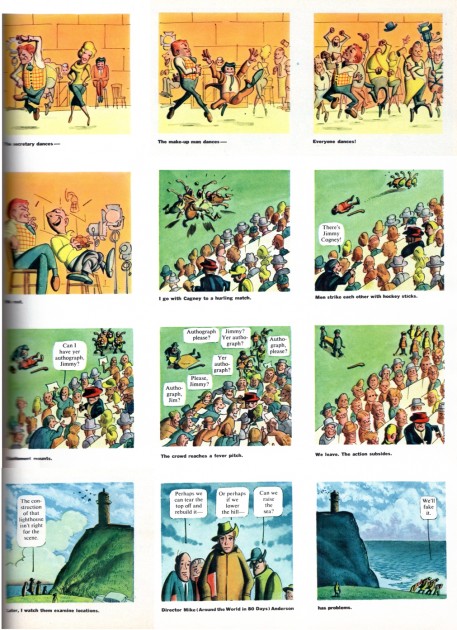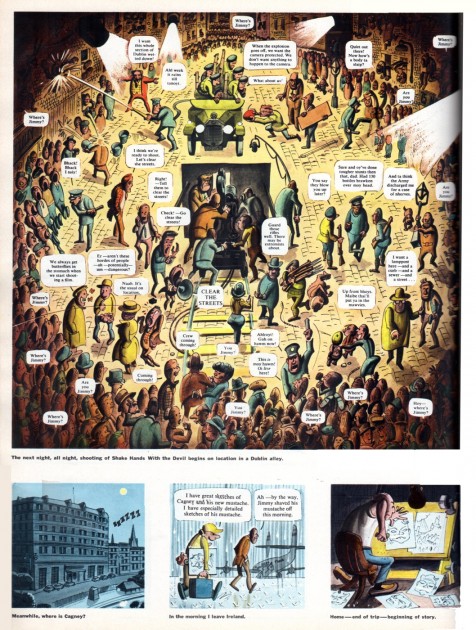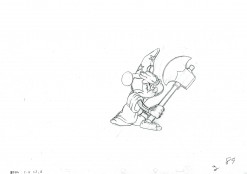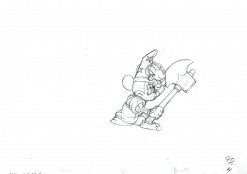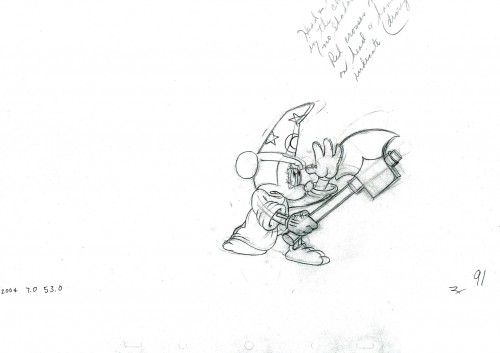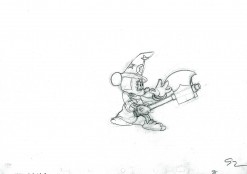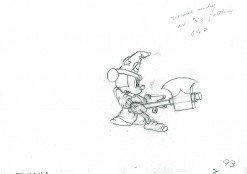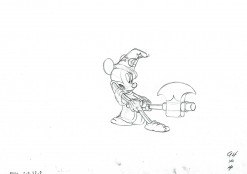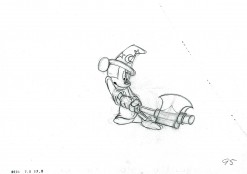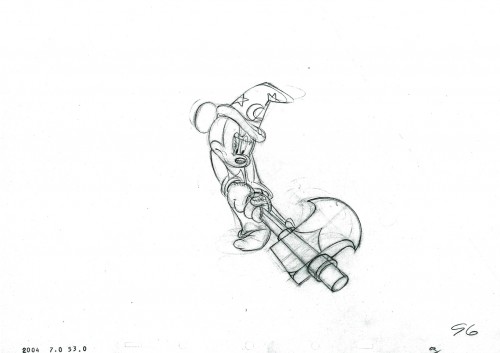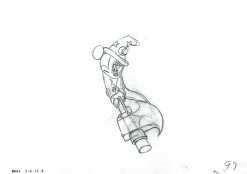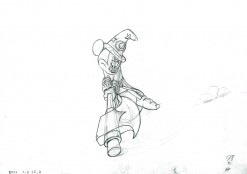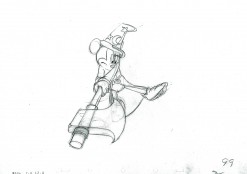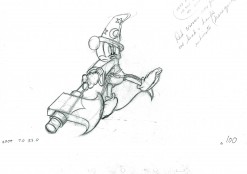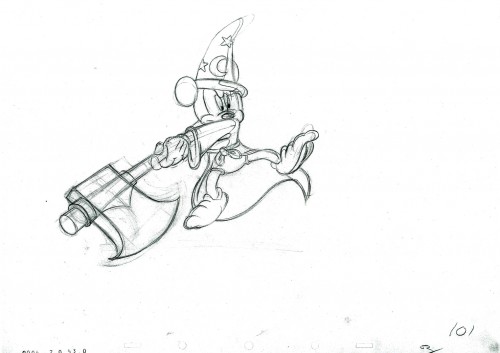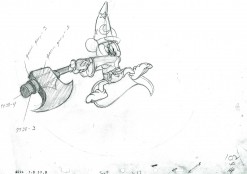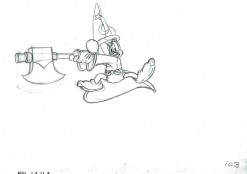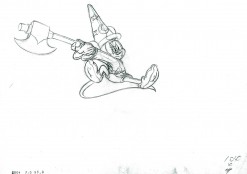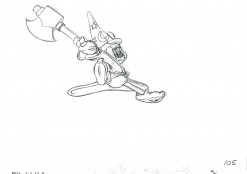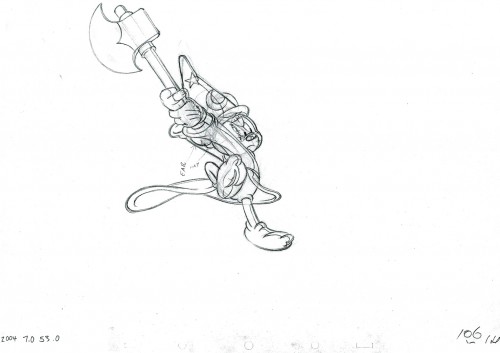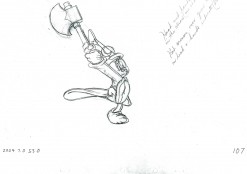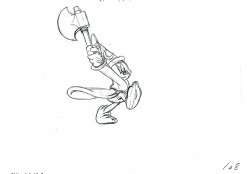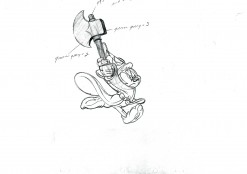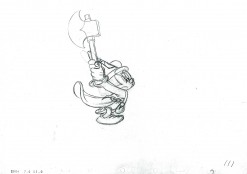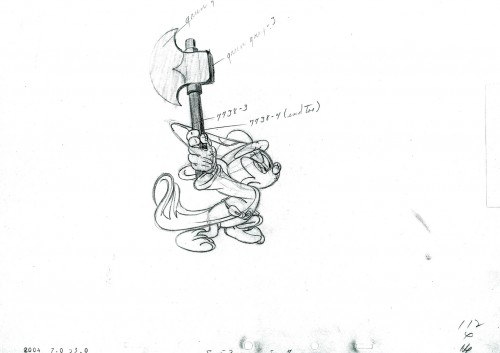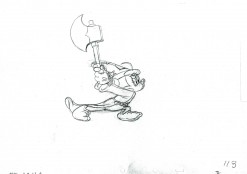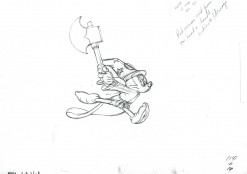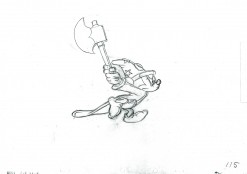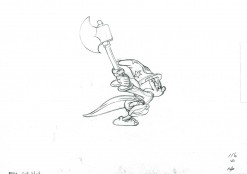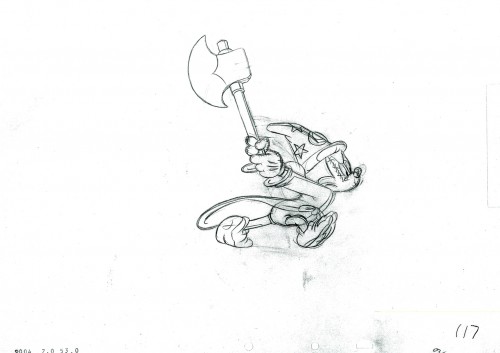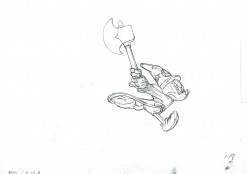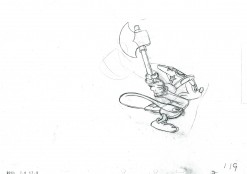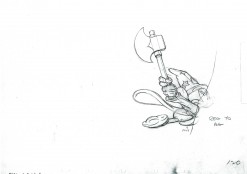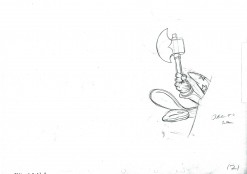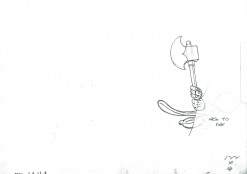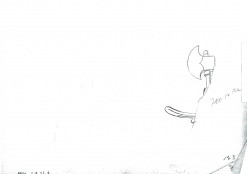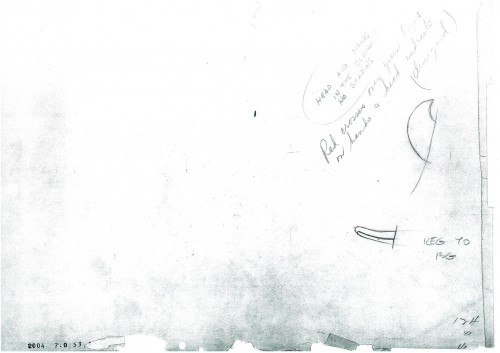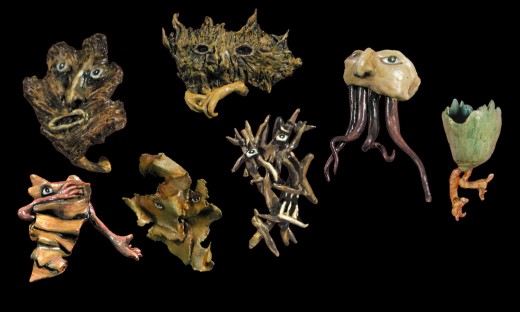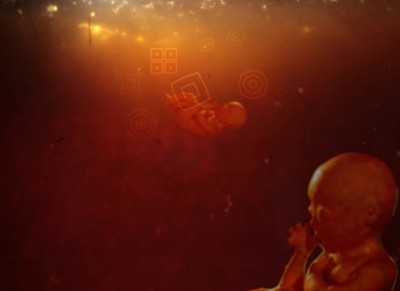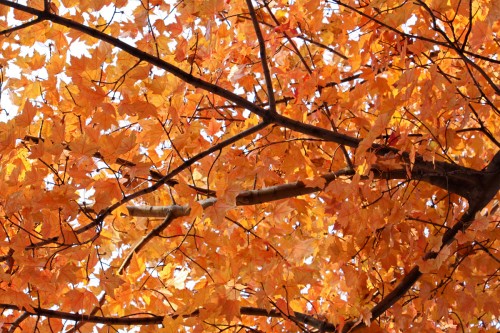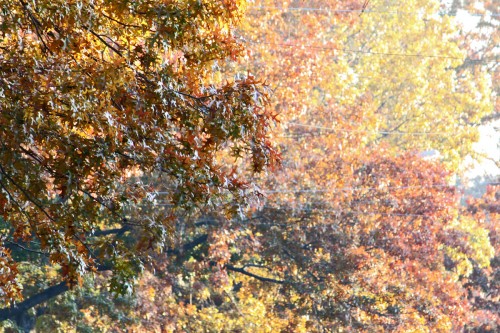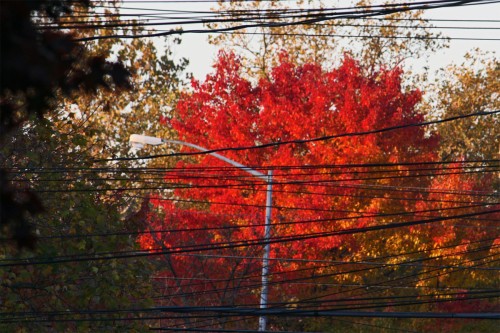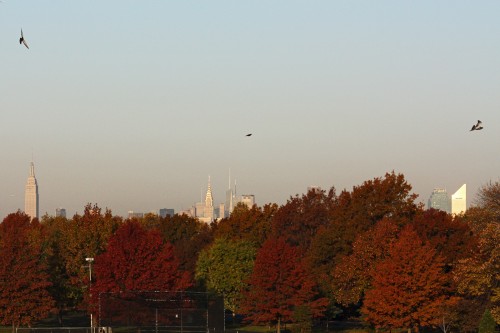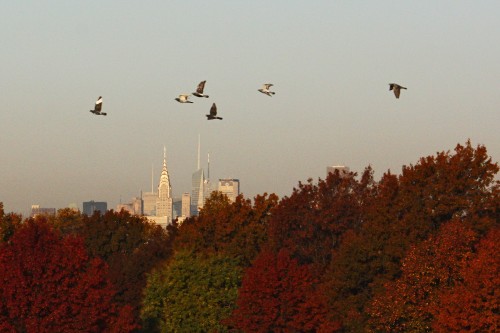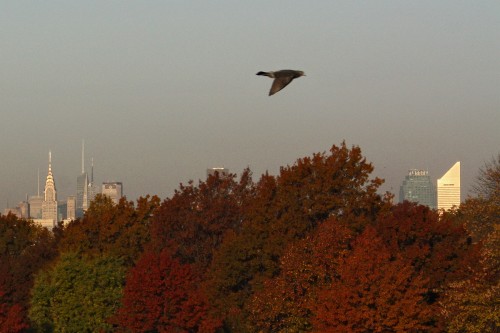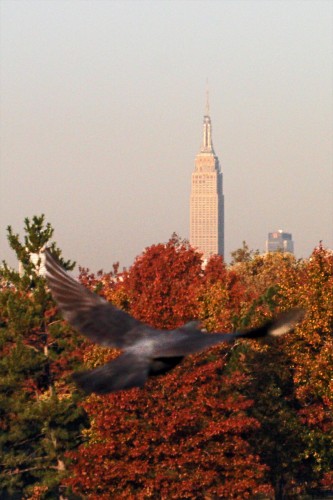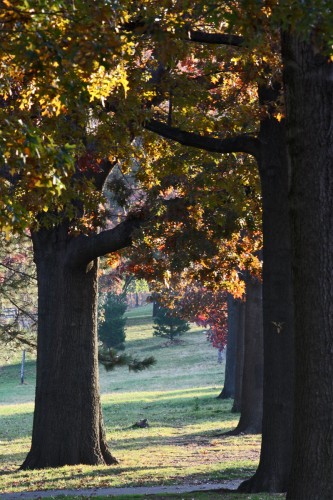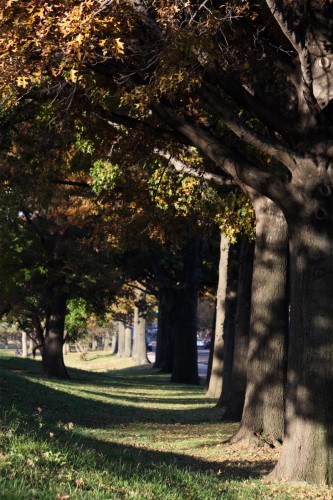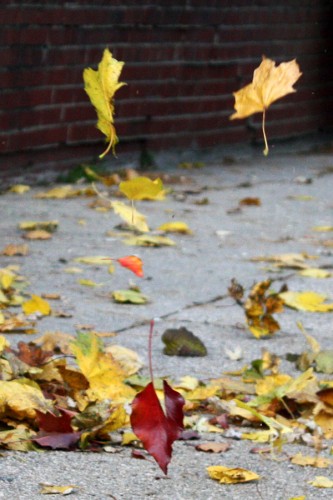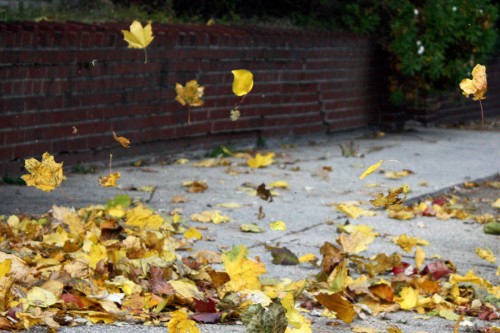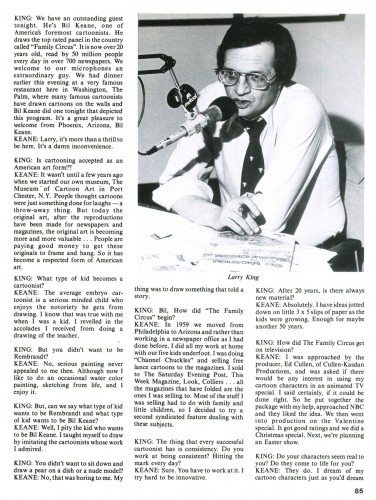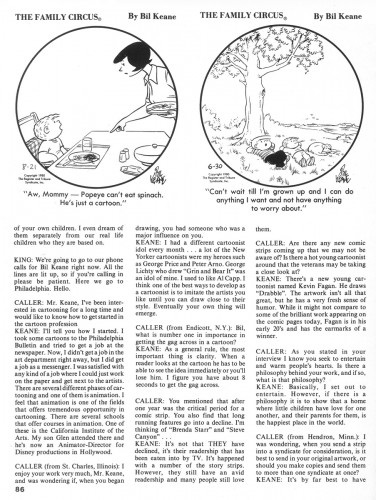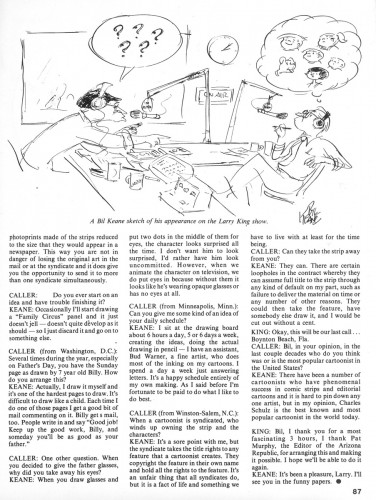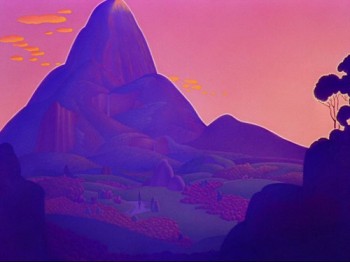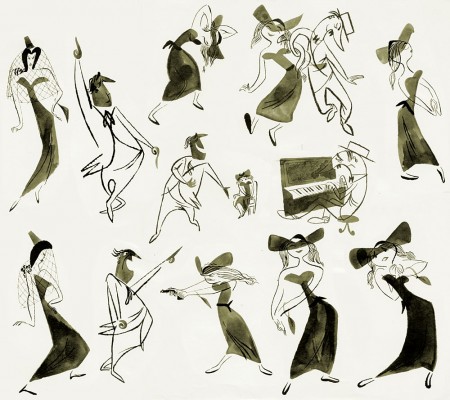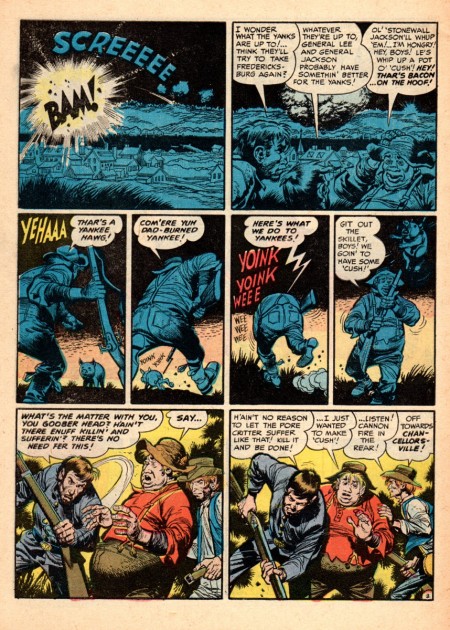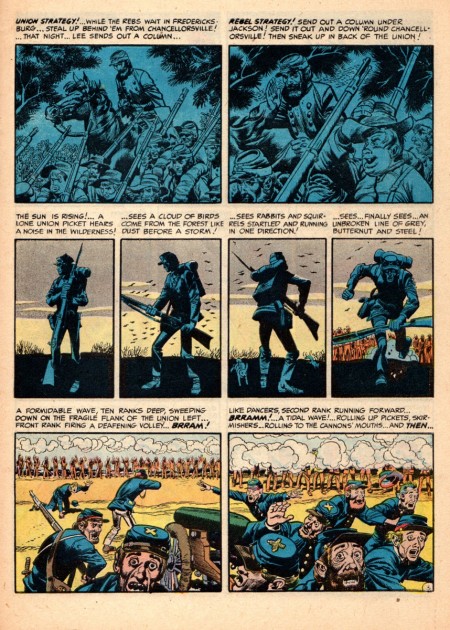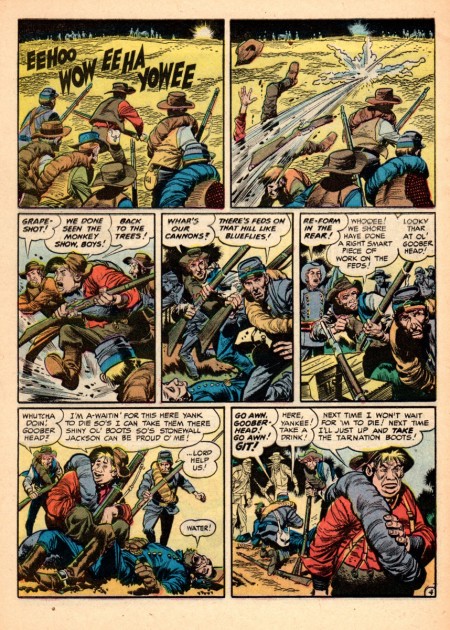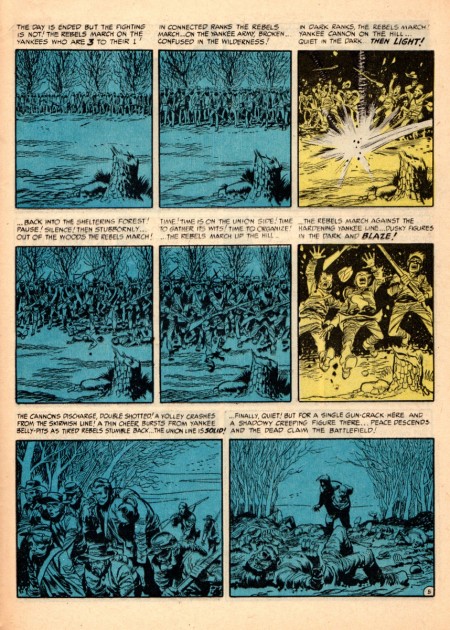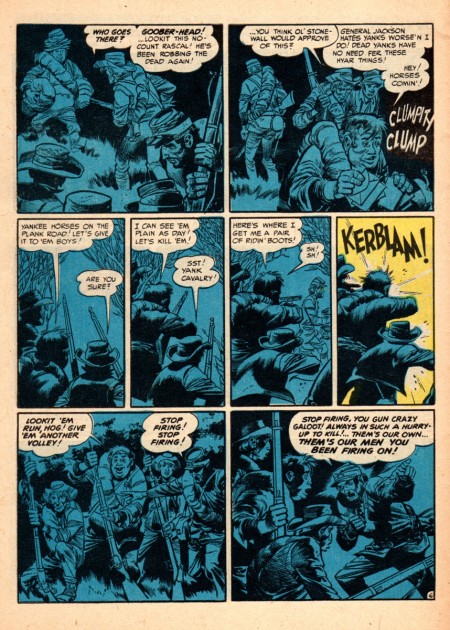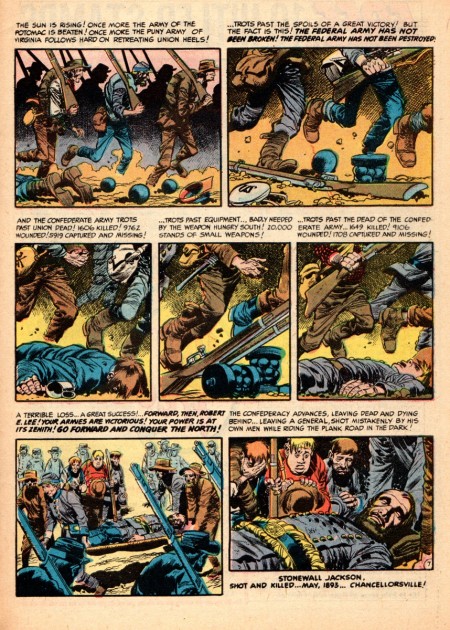Monthly ArchiveNovember 2011
Animation Artifacts &Photos &repeated posts &Richard Williams 20 Nov 2011 08:29 am
Raggedy Photo Sunday – a repeat
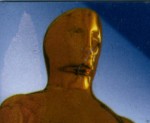 - Yesterday, with a couple dozen other hearty souls, I sat through the screening of the animated shorts to narrow them down to a short list of about ten. The 44 films took ten hours to screen (including a 45 min. lunch break and three other 15 min. breaks.)
- Yesterday, with a couple dozen other hearty souls, I sat through the screening of the animated shorts to narrow them down to a short list of about ten. The 44 films took ten hours to screen (including a 45 min. lunch break and three other 15 min. breaks.)
The first 1/2 to 1/3 of the program was brutal, and it looked like it was going to be the worst screening of films we’d ever attended. But then things got much better, and a lot of excellent films showed up in the mid third group. Then the end portion of the program turned up even a greater number of brilliant films. The end result was that it was one of the best screenings I’d seen (quality wise.) You can see the full list with some links on Cartoon Brew. The top ten should be a good group (given that a few of the choices usually turn out to be clunkers – there’s no accounting for taste.) I’m looking forward to hearing what will be on the short list.
I originally ran this piece in November 2006. I’ve made some slight adjustments to bring it up to date.
- Today is photo Sunday.
Having recently pored over some of the artwork from Raggedy Ann & Andy (the NY contingent of the 1977 feature film), I wondered if I had any photos that I could post. There weren’t many that I could find quickly, but the few I did find are here.
The first two stills were taken for the John Canemaker book, “The Animated Raggedy Ann & Andy.” I think only one of the two appears in the book.
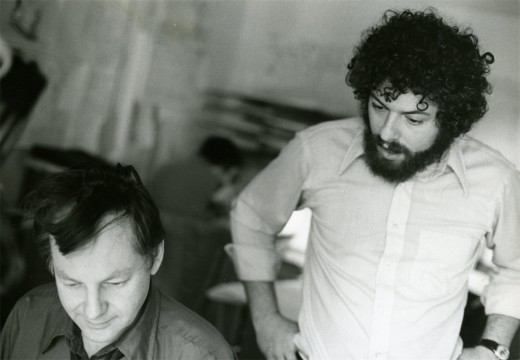
(Click any image to enlarge.)
Obviously, that’s Dick Williams with me looking over his shoulder. Oddly I remember being in this position often during the film. It’s probably the first image I have of the production when I look back on it. Dick and I had a lot of conversations (about the film) with him “going” and me listening.
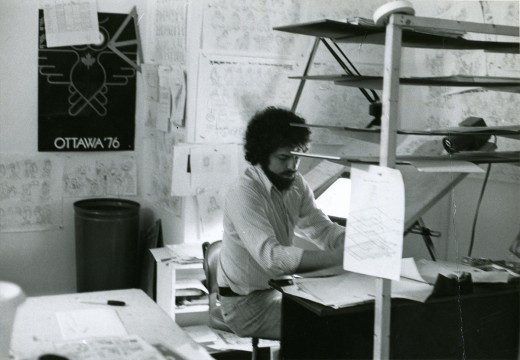
When I did actually grab time to do some drawing, this is my desk. It sat in a corner of a room – across from Jim Logan and Judy Levitow. There were about ten other assistants in my room, and there were about seven rooms filled with assistants on the floor. I had to spend time going through all of them making sure everybody was happy.
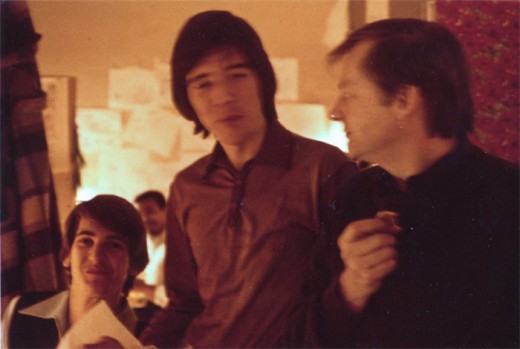
This slightly out of focus picture shows Dick Williams (R) talking with Kevin Petrilak (L) and Tom Sito. That’s Lester Pegues Jr. in the background. Boy were we young then!
These guys were in the “taffy pit,” meaning they spent most of their time assisting Emery Hawkins who animated the bulk of the sequence. Toward the end of the film, lots of other animators got thrown into the nightmarish sequence to try to help finish it. Once Emery’s art finished, I think the heart swoops out of that section of the film.
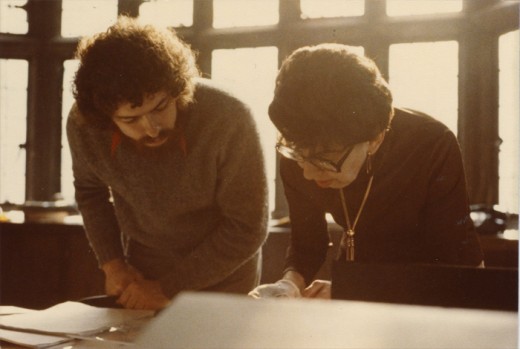
This photo isn’t from Raggedy Ann & Andy, but it just might have been. That’s the brilliant checker, Judy Price showing me the mechanics that don’t work on a scene on R.O.Blechman‘s Simple Gifts. This is the one-hour PBS special that I supervised after my Raggedy years. However, Judy was a principal on Raggedy Ann, and we spent a lot of time together.
Ida Greenberg was the Supervisor of all of Raggedy Ann’s Ink & Paint and Checking. She and I worked together on quite a few productions. I pulled her onto any films I worked on after Raggedy Ann. She was a dynamo and a good person to have backing you up.
I’m sorry I don’t have a photo of her from that period.
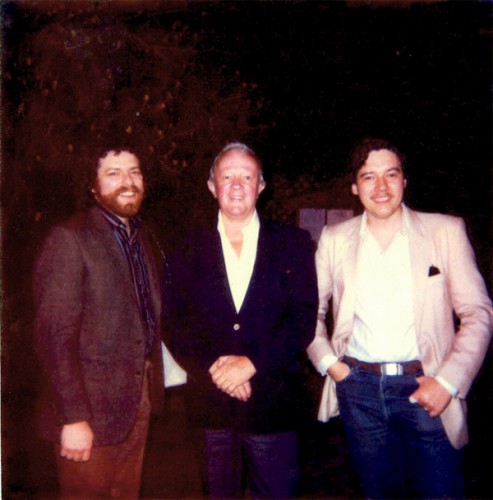
This is one of my favorite photos. Me (L), Jim Logan, Tom Sito (R). Jim was the first assistant hired after me – I’m not sure I was an assistant animator when they hired me, but I was being geared for something. The two of us built the studio up from scratch. We figured out how to get the desks, build the dividers, set up the rooms and order the equipment.
To top it all, Jim kept me laughing for the entire time I was there. I can’t think of too many others I clicked with on an animation production as I did with him. He made me look forward to going into work every day.
We frequently had lunch out, he and I, and I think this is at one of those lunches when Tom joined us. It looks to me like the chinese restaurant next door to the building on 45th Street. Often enough, Jim and I would just go there for a happy hour cocktail before leaving for the night.
I should have realized how important that period was for me and have taken more pictures. Oh well.
Bill Peckmann &Commentary &commercial animation 19 Nov 2011 07:55 am
Oscars, Miyazaki, & other things
- This was a packed week. I saw a lot of films; I mean a lot. Here are some short short comments.
Sunday: My Weekend with Marilyn The movie was good; Michelle Williams was out of this world. She’ll definitely be nominated. B+
Monday: Saul Bass Tribute The film titles were brilliant (though I would have had a larger assortment.) The logos were magnificent. All of the speakers were dull. B+
Tuesday: Puss in Boots Some brilliant design work, a few nicely animated scenes. Tiresome plot with an exhausting sound track. C-
Tin Tin The same problem as Puss in Boots. Go Go Go Go Go, then it’s over. LOUD sound track and never resting camera. Spielberg has it constantly moving around and over and under the characters. For no purpose other than to show that he can. Zero character development. C
Wednesday: The Descendants This was a very fine film. A seemingly relaxed pace to a somewhat chaotic story. George Clooney was fine in the lead role, and others around him were equally good. A-
Thursday: The Artist A fun and very romantic film. The 10 mins where they steal Bernard Herrman’s soundtrack from Vertigo was my favorite. Nice acting. B+ Harvey Weinstein threw a great after party.
Friday: Dinner with friends. A large contingent of Academy voters came down from Canada and are staying with Candy Kugel and George Griffin so they can attend the voting today. I joined Candy and the others at dinner and had a good time catching up. Three cheers for Candy for coordinating events with this group (Last night, there were 11 of us out to eat.)
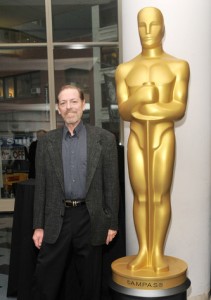 - Today there’s the Academy screening of animated shorts in NY – 45 of them. This is the first vote on the full list of those that have successfully qualified for the competition. It certainly doesn’t mean that any of them are good; it just means that they’ve followed the rules.
- Today there’s the Academy screening of animated shorts in NY – 45 of them. This is the first vote on the full list of those that have successfully qualified for the competition. It certainly doesn’t mean that any of them are good; it just means that they’ve followed the rules.
Today’s voters will select a group of 6 to 10 films to make the short list. These will be open to another voting in January to narrow it down to the five nominees.
45 shorts will probably take about six to seven hours to screen. All in one sitting with a one hour break for lunch. Usually, the lunchtime conversation isn’t about the films but about general conversation. You have to be careful not to insult any film makers who might be there.
The full list was laid out on Cartoon Brew this week. It was only two years ago that I listed those competing and received severe warnings from the Academy for having done so. Now, they release the titles, themselves. It’s something they should have been doing all along.
Hopefully, the films will be a better assortment than last year’s selection.
December 16 to Thursday, January 12 will be Studio Ghibli time in NYC. G-Kids will present a retrospective of Miyazaki‘s feature films at the IFC Center in New York this Christmas. The titles to be shown include: Spirited Away, Princess Mononoke, My Neighbor Totoro, Nausicaa of the Valley of the Wind, Castle in the Sky, Ponyo, Howl’s Moving Castle and Kiki’s Delivery Service. All will be shown in both dubbed and subtitled versions.
- The brilliantly funny Xeth Feinberg has been posting Reasons 2B Happy on a daily basis. It’s the only way to get through that first cup of coffee. Check it out . . . DAILY.
- Leif Peng has posted four storyboards for Cheet-o’s Mouse commercials done by Bill Peckmann. They’re on the site: Storyboard Central. They were done in the style of Paul Coker Jr. for PK&A (Phil Kimmelman & Ass.)
MTV has put up 20 episodes of The Head on their video website. If you’re a fan of this Eric Fogel show, you can now watch the online for free. The Head is the 5th series, joining Aeon Flux, The Maxx, Wonder Showzen, and Liquid Television on the site.
- And Bill Benzon continues with his assessment of Fantasia’s Pastoral Sequence. He’s just finished his fifth piece and has one more left in him before wrapping up the entire film.
Bill Peckmann &Illustration 18 Nov 2011 06:41 am
Jack Davis Time Covers
- Bill Peckmann received a host of Time Magazine ruffs from Jack Davis. Bill has forwarded them to me for the blog, and he’s added a few final covers with that. It all makes for a fun posting, and I hope you enjoy it.
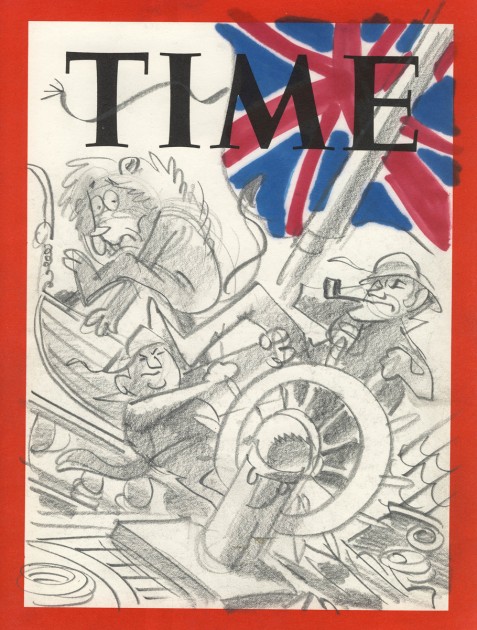 1
1
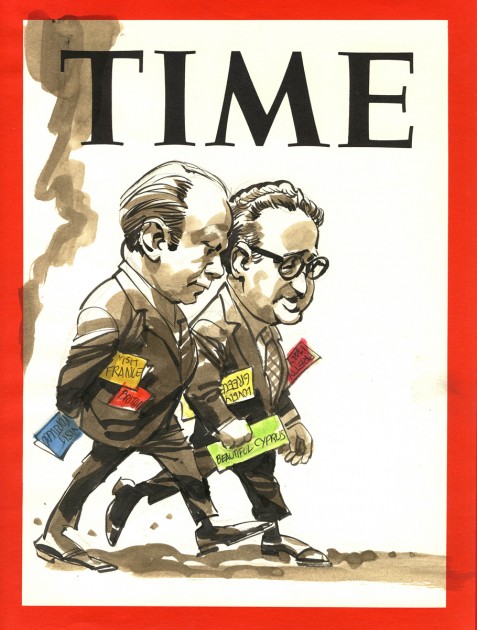 3
3
I just love this image. Great caricatures.
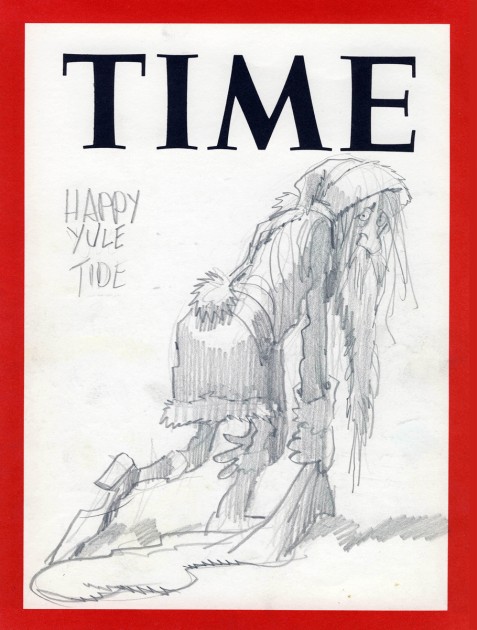 13
13
This one’s a ruff for the next image.
The remaining images are from the final covers
Oh, yes. One last thing, a self caricature by Jack Davis:
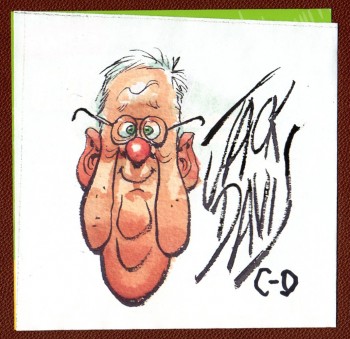
Many thanks to both Bill Peckmann for the loan and scans of the material and
to Jack Davis for graciously allowing us to post it.
There was a reuniting of MAD Magazine artists in Savannah, GA. Here’s an Associated Press Article about the meeting. In attendance were: Jack Davis, Sergio Aragones, Al Jaffee, and Paul Coker Jr.

Jack Davis (L) and Al Jaffee (R)
Bill Peckmann &Comic Art &Daily post &Illustration 17 Nov 2011 07:58 am
Kurtzman’s “Lucky” and “Cagney”
- We seem to have run out of pieces that Kurtzman and Davis have worked together in creating. So this week, Bill Peckmann has supplied me with two pieces. Today we have one on Harvey and tomorrow we have a special one from Jack.
- Here’s a story by Harvey Kurtzman that Bill Peckmann recently contributed. Bill writes:
- Here’s a Kurtzman collection that could be called, “10 years, what a difference time makes”. The first piece of work was done in 1949 and the second piece was done in 1959.
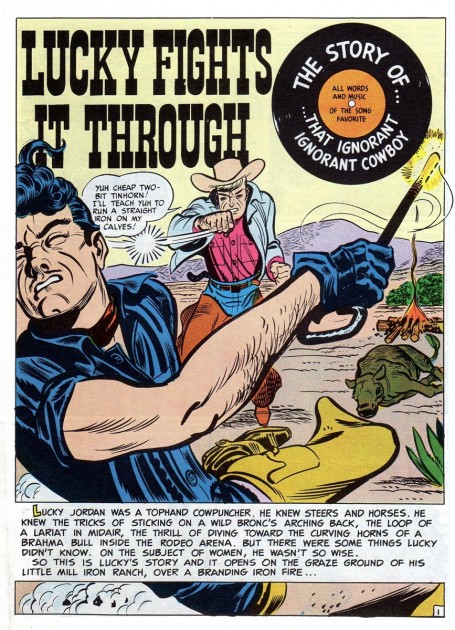 1
1In 1949 Harvey did a comic book story titled “Lucky Fights It Through”.
It was the first piece of work he did for EC. It was a 16 page educational
comic done for the public by EC Comics when they were in the process of
transitioning from “Educational” to “Entertaining” comics.
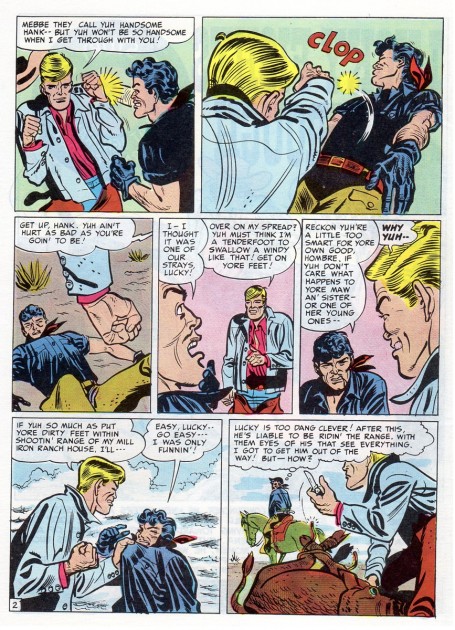 2
2
Even though it wasn’t done for one of EC’s main titles, it did get Harvey
through the door, he was able to show his prowess, the editors noticed
and the rest is history.
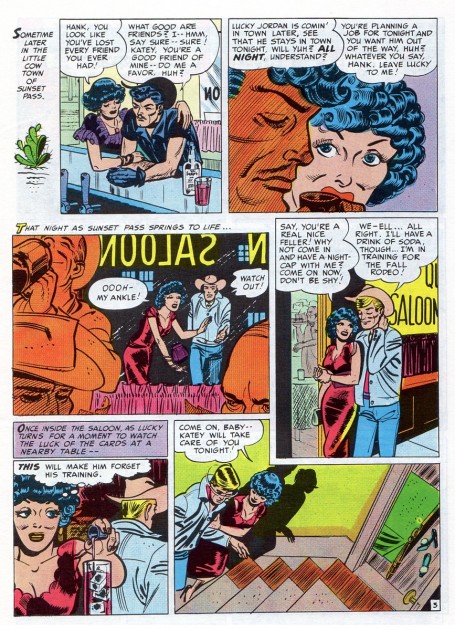 3
3
The scans are from a reprinted version that appeared in
John Benson’s fanzine “Squa Tront”, issue No. 7.
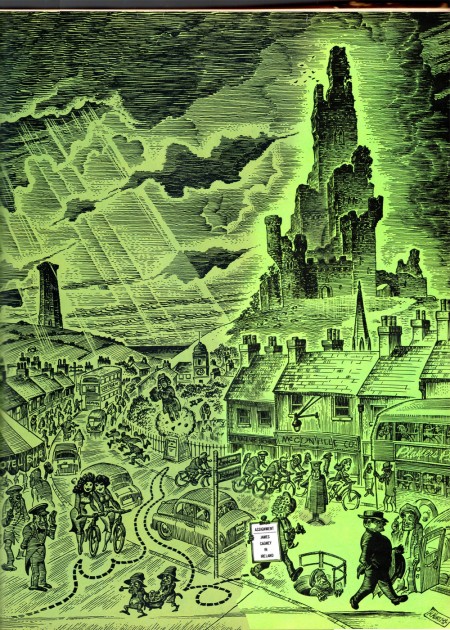 1
1
The year is 1959. MAD magazine, TRUMP magazine and HUMBUG
are all history for Harvey Kurtzman. He had to turn to free lance work.
Fortunately at that time, Harold Hayes editor of Esquire magazine was
a big Kurtzman fan and gave Harvey this story,
“Assignment: James Cagney In Ireland”, to do.
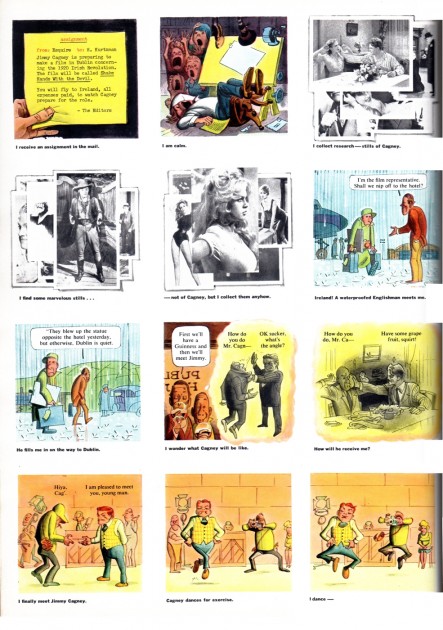 2
2
Hayes sent Harvey to cover the shooting of Cagney’s “Shake Hands With The Devil” movie. The film set was in Dublin and this is Harvey’s take on the whole experience. It’s one of the best things he ever did.
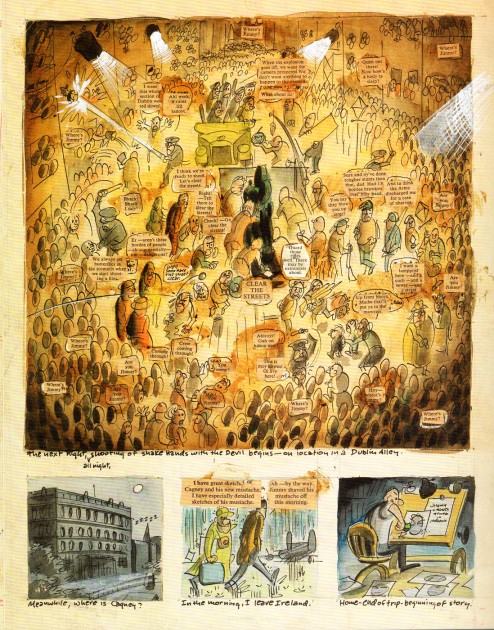
Here’s Harvey’s rough for the last page of the Esquire story.
It’s taken from “The Art of Harvey Kurtzman, The Mad Genius
Of Comics” by Denis Kitchen and Paul Buhle.
The book contains the whole Esquire Cagney story plus all of
Harvey’s roughs for the story. This alone is worth the cover price
of this excellent/outstanding book on Harvey and his work.
Many thanks to Bill Peckmann for assembling this post.
Action Analysis &Animation &Animation Artifacts &Disney 16 Nov 2011 07:14 am
Mickey and the Brooms – 3
- This is the third part of the famous scene from Fantasia wherein Mickey Mouse finally kills off the non-stop broom. He axes it into pieces. This post concludes all the drawings of Mickey; from here on out we have Mickey’s shadow doing the dirty work.
The scene was animated by
Riley Thomson with an assist from Harvey Toombs.
The sequence was directed by Jim Algar.
This is production #2004- Seq. 7 – Scene 53. It runs 28 ft. 3 frs.
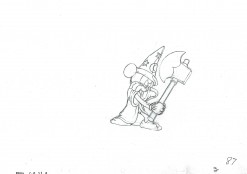 87
87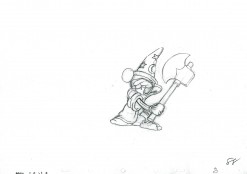 88
88
____________________________
The following QT incorporates all the drawings from this post
as well as the previous posts, Part 1 & Part 2.
All drawings were exposed per the Exposure Sheets.
Independent Animation 15 Nov 2011 06:55 am
Lisa Crafts – Independent Animator
- Lisa Crafts is a brilliant animator, designer, film maker and artist. She’s also an excellent friend. We worked together on a number of films I made in the ’80s, and her scenes still sparkle unlike many others in those films. The humanity she brought to the character of Abel in ABEL’S ISLAND just knocked my socks off. When he found a time piece on the island and brought it back to his camp, he said the ticking reminded him of his wife’s heart; he felt it brought him closer to the partner he’d been separated from. Lisa went a step beyond the layout by having Abel physically embrace the watch. There was just so much warmth in that gesture; it solidifyed the scene and said so much about the character.
Of course, I brought her into the projects because her Independently made films reflected every bit of that warmth, and I knew she would offer so much to the films. She did.
I am proud to host this Q&A and to give a small showcase to her great work
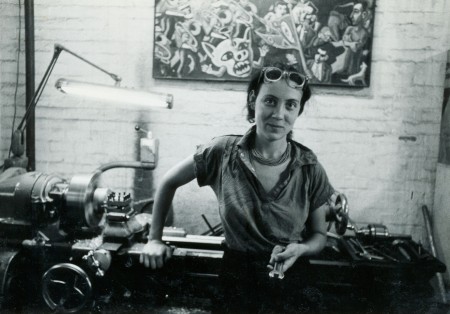
Lisa at the lathe
Michael: Can you tell us a bit about your start? What brought you to animation? Did you go to school for it?
Lisa: I grew up in New England, and was a kid who created imaginary worlds in my backyard, my closet, or in any nearby fallen tree or sandpit. I started shooting photos at age 8, when my dad gave me a camera he got from his friend who owned a pawnshop. In high school, I drew, painted, made pottery, and joined a darkroom class the high school art teacher offered. An experimental filmmaker, Ken Brown, visited our class. He was then making lightshow films for the Boston Tea Party, the premier Boston rock club. He showed us how to make flipbooks and pixilation, my first exposure to animation techniques.
The summer I turned 17, I developed and ran an art school for kids and was commissioned to paint a psychedelic mural on a garage door. As soon as I finished and got a check, I bought a plane ticket to London. I hitchhiked around England and Wales, and had an odd variety of coming-of-age experiences. Returning to the States, I worked an eclectic array of day jobs, and painted or drew at night. One day, while returning some Gregorian chant records to the library, Ken Brown drove by. He beeped, and backed up. He was again teaching in my hometown, had met my sister, and discovered that we both had been to the Isle of Wight music festival in England that summer. He said he had made a movie there. Curious, I got into his 1940 Chevy, and we’ve been together ever since.
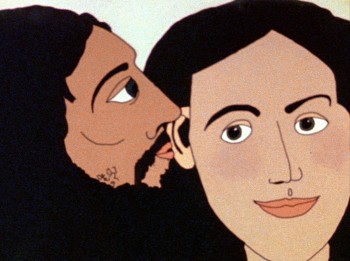
“Desire Pie”
After an extended road trip around Mexico, we moved to Cambridge, and I started making lots of super-8 flipbook and cutout animations. My flipbook films grew in length, and I wanted to learn how to put sound on them. I snuck into the animation class at Harvard with the gracious cooperation of the faculty, and an administration that looked the other way. It was there that I made my first 16mm cel animation with sound, Desire Pie, and met Suzan Pitt, George Griffin, Kathy Rose, and many other animators.
Michael: Your early work seems to have been aggressively sexual (UNGLOVED HAND, PITUITARY, DESIRE PIE) yet you started to move away from this theme with GLASS GARDENS and become more subtly political
Lisa: Perhaps at the time, just being a woman making a film on any aspect of sexuality could be seen as an aggressive or political act. But I prefer the word exuberant. DESIRE PIE is a fun loving explicit sex film, and PITUITARY, a hand colored found – footage film, is a wry and paranoid tale of the myths and misconceptions surrounding body changes in adolescence. UNGLOVED HAND, a cel animation, is a comment on sex role stereotyping.
Michael: This film also varied from the others in the cutout style of artwork and the high rendering involved. What prompted this change? Your pre-computer film work varies from more traditional and flat ink & paint style of DESIRE PIE to the very rendered hand-drawn animation of GLASS GARDENS (using cutouts). What determined the style you would aim for in each of the films?
Lisa: After two cel animations, I stopped enjoying drawing hard black lines with flat colors. I returned to cutout animation so I could have the joy of creating obsessively detailed and textured images. I discovered that what excites me in artmaking is going hunting with my camera, constructing evocative environments, and creating emotionally resonant experiences, often laced with social or political issues. My process also involves improvising, inventing, and making stuff with my hands.
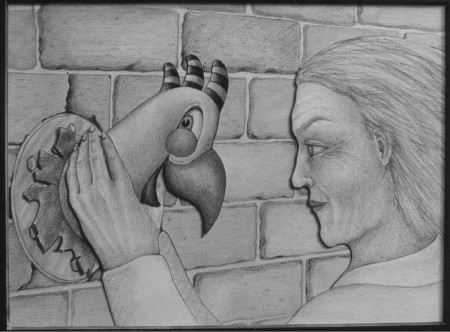
GLASS GARDENS
So I started working on GLASS GARDENS, an allegory about the role creativity plays in the survival of the human spirit. After I wrote the piece, I storyboarded it loosely so I could keep as much spontaneity in the work as was possible, and have creative invention every day. I rode my bike and photographed various background elements, and asked friends to give me objects that I could incorporate into scenes. I drew with graphite on paper, referencing elements from my photos and the objects friends had given me. The landscapes played a large role in this film, as they have in all of my work since then. Just like the play I engaged in as a child, creating worlds that tell a story is an important part of my work.
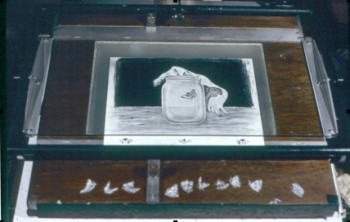 After nine months, the artwork was finished, but I no longer had access to the Oxberry animation stand at Harvard, and to rent one was prohibitive. I was introduced to Peter Lindenmuth, an amazing Einstein-like inventor, and he looked at the Oxberry, drew up blueprints, and told me that if I worked with him, he would charge me $9 an hour to build one. I spent six months working at Nexus Machine Shop-Gallery with Peter. We also worked with my dad, a carpenter, and together we built the stand that I shot Glass Gardens on. Having my own stand was liberating, I was no longer dependant on stealing in during school breaks or weekends, and had a place to experiment. It also allowed me to help other animators, like Karen Aqua, who lived down the street.
After nine months, the artwork was finished, but I no longer had access to the Oxberry animation stand at Harvard, and to rent one was prohibitive. I was introduced to Peter Lindenmuth, an amazing Einstein-like inventor, and he looked at the Oxberry, drew up blueprints, and told me that if I worked with him, he would charge me $9 an hour to build one. I spent six months working at Nexus Machine Shop-Gallery with Peter. We also worked with my dad, a carpenter, and together we built the stand that I shot Glass Gardens on. Having my own stand was liberating, I was no longer dependant on stealing in during school breaks or weekends, and had a place to experiment. It also allowed me to help other animators, like Karen Aqua, who lived down the street.

Caleb Sampson performing OCTOPUS’ EXULTATION
After Glass Gardens, I collaborated with composer Caleb Sampson on an hour-long, 3 act music/animation performance called The Octopus’s Exultation. The piece was fairly abstract, with a theme of security and chaos. It was a mixture of cel and marker animation, done on tiny 5 field cels or cards, and drawn in a loose, expressionistic style. The animation was projected with hundreds of hand drawn slides and various lighting effects. We performed it a bunch of times in Boston, and Caleb‘s music became a hit on the local radio stations.
In 1984, I curated a program of American Independent animation and brought it to three cities in Japan. Sayoko and Renzo Kinoshita were the directors of ASIFA in Tokyo, and they asked me to make a film for the first Hiroshima International Animation Festival of peace and love the following year. Reagan was actively rattling swords at that time, and many artists were making work in reaction to the nuclear threat. I wanted to make a film that could reach a wide audience, not just preach to the converted. So I decided to make a commercial for nuclear disarmament, Shout! It was a somewhat subversive project in that I didn’t put my name on, but found an anti-nuclear organization to call it their own, and using their letterhead, got it shown on over 400 television stations worldwide. It premiered at the Hiroshima Animation Festival in 1985.
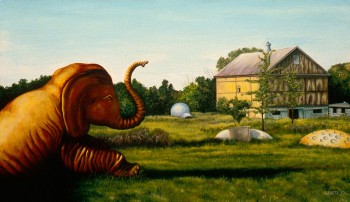 During the years when I first moved to NY, despite working in the industry, I felt I couldn’t afford the time to make another independent animation, so I painted instead. I created quietly disturbing psychological landscapes, which reflect the dreamlike dissonance of the American roadside. As with Glass Gardens, this body of work was referenced from photographs I took when Ken and I travelled America’s blue highways in search of roadside attractions, visionary environments, and vanishing Americana.
During the years when I first moved to NY, despite working in the industry, I felt I couldn’t afford the time to make another independent animation, so I painted instead. I created quietly disturbing psychological landscapes, which reflect the dreamlike dissonance of the American roadside. As with Glass Gardens, this body of work was referenced from photographs I took when Ken and I travelled America’s blue highways in search of roadside attractions, visionary environments, and vanishing Americana.
Michael: Your post-computer animation is certainly more highly rendered. THE FLOODED PLAYGROUND and OVERGROWTH are almost moving into an interpretation of live-action via the animated cutout. Do you feel most content with this work you’ve been doing using computer programs?
Lisa: I’ve always liked dancing on the precipice between the real and the imagined, so yes, the results of working digitally is very satisfying. I can create worlds from a blending of all of my artforms: photography, sculpture, drawing, stop-motion, video and painting. It gives me enormous room for experimentation and discovery.
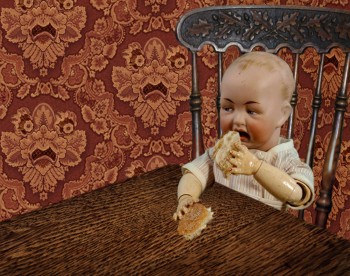
THE FLOODED PLAYGROUND
THE FLOODED PLAYGROUND is about the comforts, terror, and magical thinking of childhood that reside in us throughout our lives. Due to time/money restraints, I could only work on it a few weeks a year at the beginning, but with the aid of some grants, I was finally able to put in the hours it took to complete. During the years I was thinking and writing about it, I carried a scavenger-hunt list of elements I wanted to include, and carried my camera to collect them. I also built some of the sets, caves and creatures. The resulting environments were hybrid, often including elements from different continents, which created the somewhat familiar but indefinable places and times that exist in fairy tales.
Michael: What computer programs are you most likely to use?
Lisa: After Effects, Photoshop, Dragon
Michael: Is the next step cgi? or live action?
Lisa: Not CGI, I’d be 100 years old before that could become a natural and elegant tool for me. Since I’ve used a camera my whole life, tilting into live action is not a big stretch for me. I’m animating live action now, cutting it out from its rectangular shape and/or treating it as individual frames and reworking it.
Michael: You’ve also done a bit of commercial work in animation. A number of Sesame Street films, VH1, MTV and The Electric Company. You worked on staff for me for a while animating traditionally. What do you think of this work as compared to the more personal film work?
Lisa: Working at your studio was an illuminating experience for me. You hired me despite the fact that I was not a trained character animator. But that trial by fire worked. You treated each animator as a director, and gave us a lot of latitude, and the films reflected that generosity. I got up to speed by the time we worked on Abel’s Island, and felt each scene you handed me was my personal work, and put that kind of spirit into it.
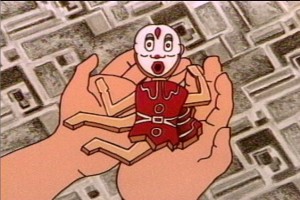 When our projects were over, I finally knew enough people in New York to freelance again. I worked on my own, then partnered with Ken, who was best known as an illustrator at that time. We did some work for music television, and then started working with Sesame Street. It was perfect timing, as our daughter was about 2 years old, and she was able to grow up watching herself, her friends, and our work on Sesame Street. We were so fortunate to have
When our projects were over, I finally knew enough people in New York to freelance again. I worked on my own, then partnered with Ken, who was best known as an illustrator at that time. We did some work for music television, and then started working with Sesame Street. It was perfect timing, as our daughter was about 2 years old, and she was able to grow up watching herself, her friends, and our work on Sesame Street. We were so fortunate to have 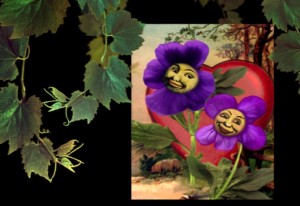 the gifted Arlene Sherman as our producer. She allowed us to flourish as artists and to write our own stories and songs, and use our own composers, voice actors, and musicians. Near the end of our time there, I told her that I was transitioning to working digitally, and hoped I could make a new piece in that style. She came to the studio to see what I was working on and gave me the go-ahead to make my first digital piece. I sometimes wonder how it would have impacted my explorations in that direction if she had wanted me to keep drawing.
the gifted Arlene Sherman as our producer. She allowed us to flourish as artists and to write our own stories and songs, and use our own composers, voice actors, and musicians. Near the end of our time there, I told her that I was transitioning to working digitally, and hoped I could make a new piece in that style. She came to the studio to see what I was working on and gave me the go-ahead to make my first digital piece. I sometimes wonder how it would have impacted my explorations in that direction if she had wanted me to keep drawing.
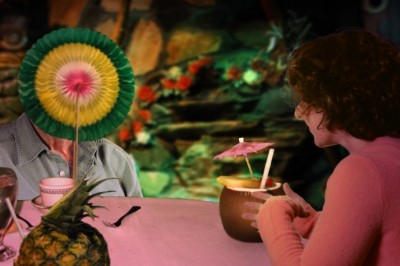
Cindy Kleine’s PHYLLIS AND HAROLD
When I built my animation stand, filmmakers started to come to me to shoot their archival still photographs, and make titles and graphics for their films. I have been working on feature documentaries ever since. In the last dozen years, some of the people I work with have become more adventurous in their use of animation. I am most regularly called on to depict interior life: dreams, memories and hallucinations. I really enjoy the research aspect of the process and being part of a creative team. Recent projects include Cindy Kleine’s film Phyllis and Harold, and Michel Negroponte’s film, I’m Dangerous with Love. I’m currently creating animated scenes for Cindy Kleine’s new doc, The Man in Question, a film about the theater director, André Gregory. While working on I’m Dangerous with Love, I started experimenting with using live action video for some of the hallucination scenes, and so enjoyed adding that spice into the mix, that it triggered my new direction.
OVERGROWTH is a very slow motion, almost live action play of the wind in the trees and shrubbery depicted in the very realistic montage art. It’s beautiful in its approach and feels like a new direction for you. Do you see it as such? I also notice that this is labeled on your website as “a sketch for a larger work-in progress.” Can you tell us a bit about the direction it’s heading toward?
OVERGROWTH was an early sketch. The new work has some of the same ideas and feeling, but it goes to a different place. It is about coming to terms with the Anthropocene era, a new geologic era that is the result of the actions of humans. I’ve been doing a lot of reading about natural history artist-explorers like Maria Sybella Merian, who in 1699, traveled to Surinam to study, draw and describe the metamorphosis of the incredible insects there. Like Merian, I am engaging with a new world, one reshaped by environmental changes.
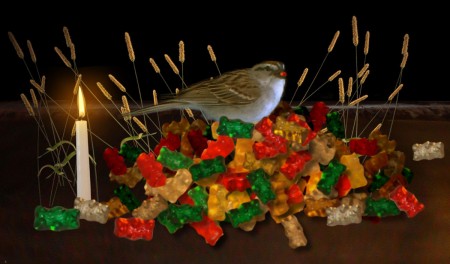
Gummibird” from OVERGROWTH
For this project, I go on frequent photographic hunting trips, often urban explorations on bicycle to fringe ecosystems in New York. I now gather video and audio as well as stills. I work in the studio for the stop-motion parts, and sometimes set up outdoor greenscreens as well. I then return to the computer to blend all the elements together. This piece is more poetry than narrative. My work is metamorphosing, and this piece is letting me know that it may not want a sit-down audience, and it may have to be installed, but that is still a question. Although my films utilize different techniques, they have the commonality of exploration, both inner and outer.
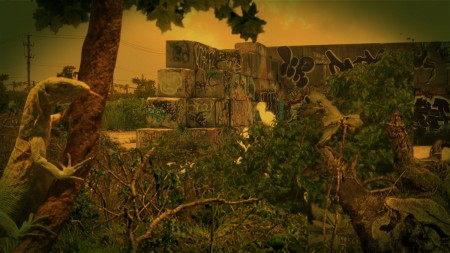
OVERGROWTH
Michael: You’ve also worked closely with your husband, the artist Ken Brown. No doubt you are an inspiration for each other, but I also wondered if you’d like to speak about your other collaborations?
Lisa: Our first collaboration was a quixotic attempt at a Felliniesque travelling show called “A Streetside Sensoriumâ€. Well, it never travelled, but we made and sold something for every sense. We built two barnboard movie boxes to show our films, filled and sewed small block-printed muslin bags with sweet balsam needles, made carrot cake, and also sold Ken’s early hand developed photo-postcards and cartoon books. We went to the cobblestone lot in front of a friend’s store in Cambridge on Saturdays, and sold our stuff and came home with enough to live on for the week.
Although we have primarily worked independently, providing each other with critique, assistance and encouragement, we have also collaborated on many projects, both for art and for jobs. We made station id’s for MTV and VH1. We also worked together on Sesame Street, Electric Company, AMC, and a couple of random commercials. Sometimes we closely collaborated, literally passing work back and forth. Other times we broke it down in various configurations, one of us producing, animating and shooting, the other one designing and inking. We determined that whoever wrote a given piece would be the director, in an attempt to avoid the situation of two independent people steering the same car.
Michael: Any other thoughts about the future for your animation?
Lisa: My plan is to keep evolving, it’s all quite a mystery.
Independent Animation &repeated posts 14 Nov 2011 08:20 am
Pups of Liberty – a recap
- In October 2009 I was impressed with the work of Jennifer & Bert Klein‘s Pups of Liberty, a short film they had completed. It was a fully animated short, and a lot of work went into it. I decided to pose some questions and interview them via email.
I was reminded of this in the past week when they dropped in at my studio just to say hello. They had business in NY and were there for a packed two days. We spent a really pleasant couple of hours and talked about our divers careers in animation. Having just met them for the first time I was surprised at how much we had in common.
After our meeting, I took another look at the two pieces I’d posted and thought I’d like to show them again. So here they are. We start with the first post in which I interviewed them for the site, and then we move onto the second post where I try to showcase some of the artwork.
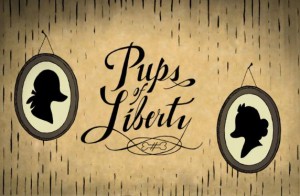 - The fortune of having a modestly successful blog is that some filmmakers actually approach me in order to get the word out about their films. Such was the case with Jennifer & Bert Klein‘s Pups of Liberty. They sent me a link to their site which offered a trailer for their short film, and they offered to send me a DVD of the entire film.
- The fortune of having a modestly successful blog is that some filmmakers actually approach me in order to get the word out about their films. Such was the case with Jennifer & Bert Klein‘s Pups of Liberty. They sent me a link to their site which offered a trailer for their short film, and they offered to send me a DVD of the entire film.
When I looked at their site and trailer, it was obvious this wasn’t your average short. I saw the very full animation, beautiful backgrounds, and I looked deeper.
I saw the credit list and the names of James Lopez (Animator on Hercules, Emperor’s New Groove, Flushed Away and Princess and the Frog), Eric Goldberg (Animator on Aladdin, Fantasia 2000, and Princess and the Frog), Barry Atkinson (BG artist on Prince of Egypt, American Tail and The Lion King), and Mark Henn (Animator Ariel, Belle, Jasmine, Mulan and Tiana) among others. I had to see this film.
I wasn’t disappointed. The animation is sterling in the richest of full animation; the Bg’s are beautifully styled to feel like the period (the Revolutionary War) they’re meant to suggest, and the Direction couldn’t be cleaner or clearer or more focused. The film doesn’t waste a shot, but drives itself through the story in a very economical approach. Yet not a dollar seems to have been spared in making this the extraordinarily lush film it is.
I had to respond to Jennifer and Bert Klein to ask for a short interview and they responded with answers to any question I posed and plenty of supportive material. Hence, I’ll post that Q&A today with some stills from the film, and tomorrow some amazingly attractive pre-production artwork. This film deserves a book of its own.
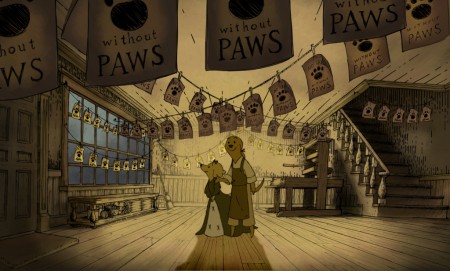
All images copyright © 2009 Picnic Productions
The Interview
Michael – What prompted you to develop this story? It reminds me a bit of Disney’s Johnny Tremaine in the way that it focuses on a particular craftsman and his daughter, just as the live action film focused on a silversmith and his apprentice. Was there any inspiration from that film/book? Animation wise, it feels a bit like Ben & Me. Perhaps that’s because of the subject.
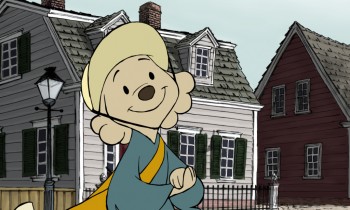 Jennifer – I have always loved this era of history (Colonial/Revolutionary America) so when I first began developing an idea for a new short it was the first setting that came to my mind. I wanted to make a story that was quality and that a viewer would feel good about watching; I was also very interested in how to teach people concepts (like taxation and representative government) with a media like animation.
Jennifer – I have always loved this era of history (Colonial/Revolutionary America) so when I first began developing an idea for a new short it was the first setting that came to my mind. I wanted to make a story that was quality and that a viewer would feel good about watching; I was also very interested in how to teach people concepts (like taxation and representative government) with a media like animation.
The story of the Boston Tea Party seemed like an iconic event to start with, since most American school kids learn about it pretty early on. The more I researched the more I was drawn to the story of the printer who started the Sons of Liberty. I love the idea of a group of ordinary people getting together to motivate change in their world, and I liked that that is something that translates internationally, to everyone.
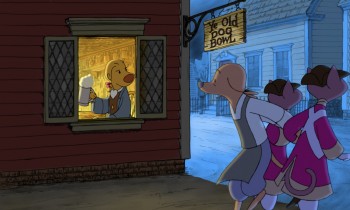 I grew up watching Robin Hood because it was the only Disney movie we had. At some point I saw Ben and Me and I have always liked that one a lot too. I like allegorical story telling, fables… so it seemed natural to tell the story with animals. In a way it lightens up the mood of it having a political bent- because really, they are talking dogs and cats.
I grew up watching Robin Hood because it was the only Disney movie we had. At some point I saw Ben and Me and I have always liked that one a lot too. I like allegorical story telling, fables… so it seemed natural to tell the story with animals. In a way it lightens up the mood of it having a political bent- because really, they are talking dogs and cats.
Bert – We initially considered making a film about the first Thanksgiving with cats as pilgrims and birds as the native Americans. We moved ahead in time a bit and did the Boston Tea Party instead.
I’m sure you don’t want to discuss your budget, but you must have gotten a lot of incredibly talented people to volunteer to help you make the film. (Eric Goldberg, Mark Henn et al). The expense easily looks quite high.
Michael - Was the budget completely out of pocket?
- How did you create such enthusiasm for the project to do so?
- Now that you’ve finished what is your hope for distribution or future development?
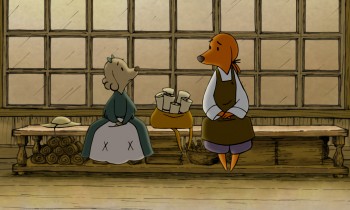 Jennifer – Our budget was all out of our own pocket. We might be a little crazy I guess, but this is what we do. It’s our hobby. Bert and I are very passionate about making shorts, and when we began the project we were also very interested in keeping ourselves in practice for 2d animation at a time when there weren’t any other 2d features being made at any of the studios. Our friends who worked traditionally started to hear about the film and we would have evenings with everyone over and do pencil tests and see them cut into the storyreel – and we’d always have pie, I would bake every night for the crew. The nights started to take on a family atmosphere, and I think everyone felt very comfortable to come and practice their art that they had been trained to do. Everyone was working at their highest skill level– Mark Henn was doing 20 feet a week, James Lopez stretched himself and all of our layouts, we had cleanup people doing the most beautiful work I had ever seen from them. I can’t say how we “created” enthusiasm because you can’t consciously create something like this. You’re just darned lucky that it happens.
Jennifer – Our budget was all out of our own pocket. We might be a little crazy I guess, but this is what we do. It’s our hobby. Bert and I are very passionate about making shorts, and when we began the project we were also very interested in keeping ourselves in practice for 2d animation at a time when there weren’t any other 2d features being made at any of the studios. Our friends who worked traditionally started to hear about the film and we would have evenings with everyone over and do pencil tests and see them cut into the storyreel – and we’d always have pie, I would bake every night for the crew. The nights started to take on a family atmosphere, and I think everyone felt very comfortable to come and practice their art that they had been trained to do. Everyone was working at their highest skill level– Mark Henn was doing 20 feet a week, James Lopez stretched himself and all of our layouts, we had cleanup people doing the most beautiful work I had ever seen from them. I can’t say how we “created” enthusiasm because you can’t consciously create something like this. You’re just darned lucky that it happens.
We are submitting the Pups to film festivals, so we will have about 2 years worth of that, and then we’ll see what happens. My biggest hope would be for a series. I would also love to see it in the classroom one day.
Michael – It must have taken quite some time since I doubt you were able to work steadily on the film and had to fit it in between other jobs. (I’ve seen your resume and know you’ve been busy outside of this film.)
- How long did it take to make, given your work schedule?
- How were you able to maintain such a consistent (and consistently high level) look while working on it on a long, piecemeal schedule? (Assuming that was the case?)
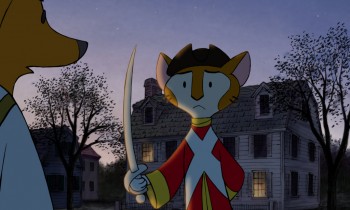 Bert – Most of the production took place during spare time over a two year period. The births of our two kids stretched out the last bits almost another two years.
Bert – Most of the production took place during spare time over a two year period. The births of our two kids stretched out the last bits almost another two years.
One way we ensured consistency was having Jennifer do clean up keys over the different animators’ drawings to maintain the style. Mark Henn did a lot of animation on the film and helped raise the bar for everyone else. One person (James Lopez who was a supervising animator at Disney for a decade) did all of the layouts. I animated a lot of it myself and just kept working on it until it was done. Our assistant director Hyun-Min Lee was invaluable to us in getting this done, tackling technical problems, organizing scenes and x-sheets, and trackreading amongst many other jobs.
Jennifer – I took some time off to work on the film, so I was able to dedicate all of my time to it. I did the boards, designed the characters, did reds for the cleanup keys. I think that the simplicity of the characters saved us a lot of line mileage and made it possible for the artists to get through the footage quickly. They also look best against the backgrounds, which are done in a hand drawn pen-and-ink style and required something simple to contrast with them. We looked at the printwork from the time for inspiration- Paul Revere’s engravings especially really had a ‘homemade’ colonial feel, and you can see his personality in them and in the brush strokes of color used that we tried to invoke.
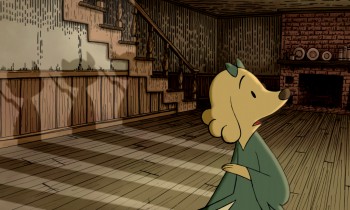 It is hard to sit down and work after you have worked a full day, but I always remembered something Bert would say- “Even if you just get one drawing done you are one drawing ahead.” So I’d try and get one scene’s worth of layouts done a night, or read a track, or just something, and we’d inch forward until we were done.
It is hard to sit down and work after you have worked a full day, but I always remembered something Bert would say- “Even if you just get one drawing done you are one drawing ahead.” So I’d try and get one scene’s worth of layouts done a night, or read a track, or just something, and we’d inch forward until we were done.
Michael – Just as American Tail was compared to MAUS, your film has already received a comment on Cartoon Brew comparing it. There are very obvious differences, but I wonder if you thought about this possibility?
- Or worried about it?
- Did you ever question the idea of doing it with humans?
- Or would that have made you focus even more on historical accuracy?
Bert – I heard of MAUS, but I’ve never read it. Our main reason to make this was purely a labor of love. I watched Jennifer do great work as a story artist on lots of feature projects for studios that never got made or changed radically from the first inception. She was one of the original story artists on Where the Wild Things Are when it was a fully animated feature back in 2001. I wanted to produce a film that was a showcase for her story sensibilities because I felt that it might be the only way to get that pure vision to the screen. We also hope that people and their kids can enjoy it.
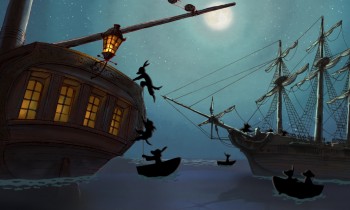 Jennifer – Honestly I never heard of Maus. Whatever subject matter you make a film about though, there will always be something to compare it to — how many films are there about aliens? Or zoo animals? A setting is just a setting- it’s how you hook the audience in, how you make them really feel for and believe in your characters, and the experience that you give them that matters.
Jennifer – Honestly I never heard of Maus. Whatever subject matter you make a film about though, there will always be something to compare it to — how many films are there about aliens? Or zoo animals? A setting is just a setting- it’s how you hook the audience in, how you make them really feel for and believe in your characters, and the experience that you give them that matters.
Doing a historical film with humans instantly makes it more serious- doing it with animals, you can’t take it as seriously and you can have more fun with it. Why animate humans when you can animate talking dogs? It made us laugh. We did it this way so that we could have some fun, and do what we love to do.
Having interviewed Bert and Jennifer Klein, I found myself with a lot of beautiful artwork and test footage to show. In posting it, I’ve kept the text descriptions, below, written by their Production Designer, James Lopez.
You can view a trailer from their film here.
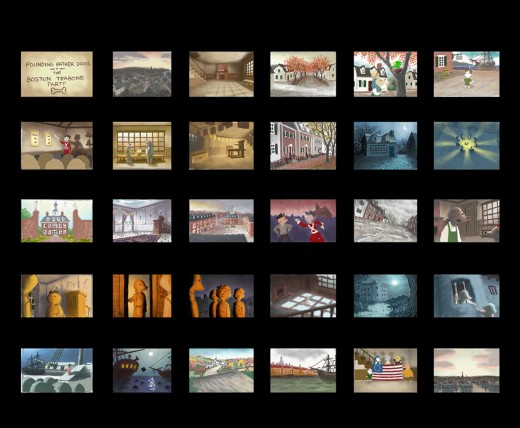
Pups of Liberty Color Script by James Lopez
For the colors, warm colors were chosen to represent the dogs’
surroundings and, in contrast, cool colors to represent the cats.
To start the film, the colors were to portray a pretty town but not
a vibrant one. Only as hope comes alive and tensions run high (The
Boston Tea Party & The Riot) are the more vibrant colors introduced.
Color influences came from some classic Disney films and a desire to
use natural lighting (direct & indirect) as opposed to “staged†lighting.
The story of the movie is left somewhat unconcluded so at the finale,
rather than going full-blown with color, there is a hint at what would be
to come (as the story’s narration suggests).
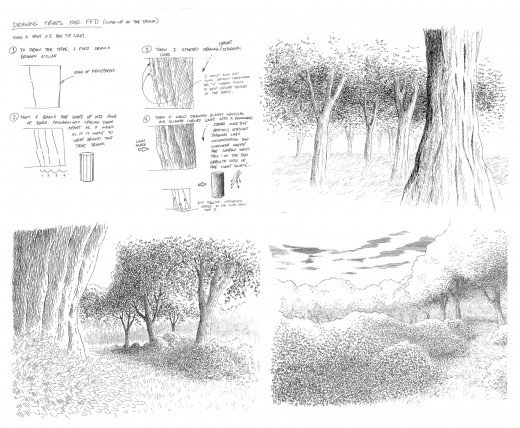
Pups of Liberty - Drawing Trees
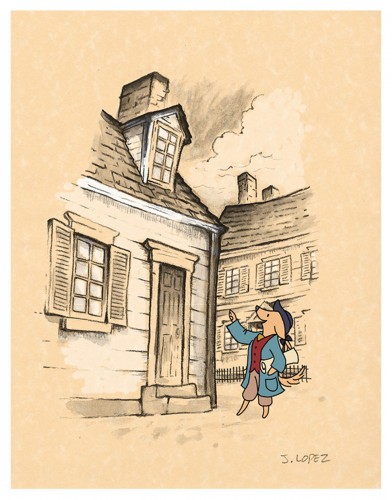
Pups of Liberty - In the style of Anton Pieck
Initally, the backgrounds were going to be influenced by the stylings
of Dutch artist Anton Pieck. Studies were made to see what the style
would look like with a Colonial theme.
A composite was made with the paint study and the character over
a parchment texture. We we were happy with the result of how the
drawn character married into the drawn environment.
It was a nice style but it involved a unique application that was a labor
to produce and proved to be impoprobable so we explored other, more
traditional styles.
We later settled for a pen and ink application on vellum paper in the
rough drawing style of the late Ken Anderson. It allowed us to stay
loose and if there were any mistakes or changes to be made, they
could still be done on paper.
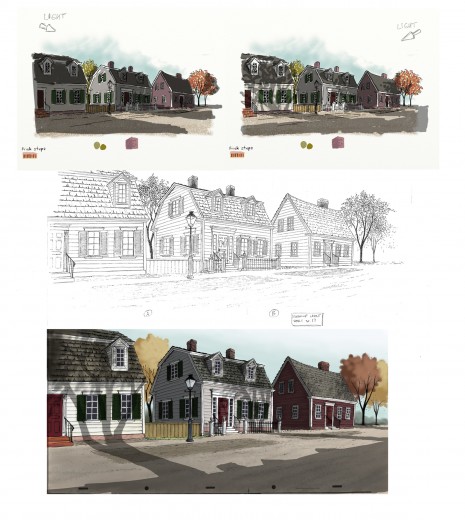
The top two illustrations are visual development for the color and
lighting treatment on the houses. The desired effect was trying to
capture the drama of the shadows cast from the trees by the sun
set low on the horizon.
The middle illustration is a clean-up layout by James Lopez
The bottom illustration is a Production Background painted by James Lopez
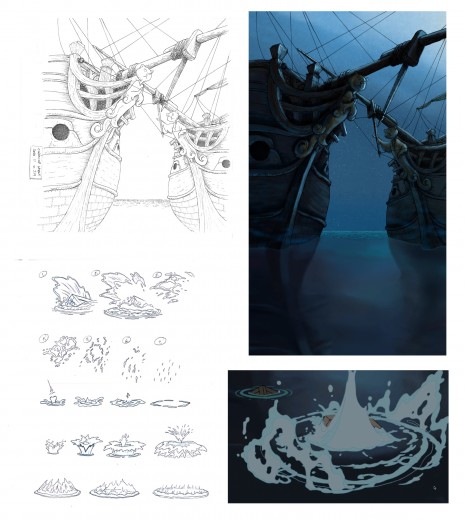
Pups of Liberty - Water Effects
Illustration (upper left) Clean-Up Layout by James Lopez
(upper right) Production Background by Barry Atkinson
(below left) water studies by James Lopez
(below right) Production still
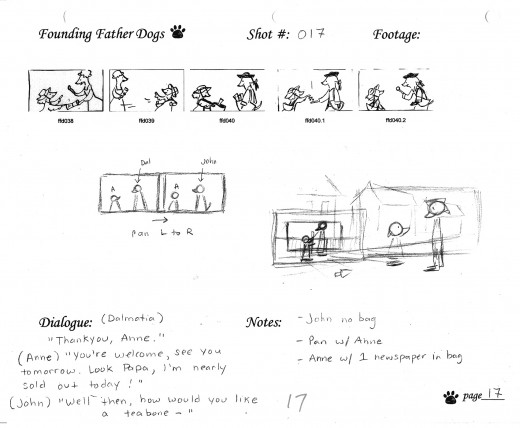
The above images represent a page from the Director’s workbook
for Sc. 17. Storyboard drawings are by Jennifer Klein.
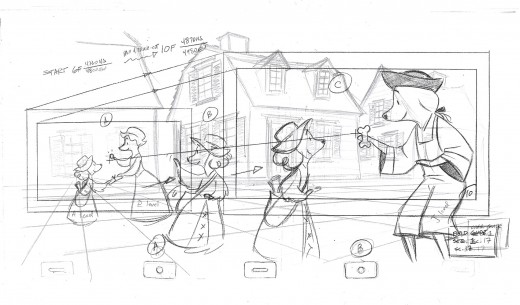
This is the Layout for Scene 17
done by James Lopez.
The QT movies below are Pencil Tests of scenes by
Mark Henn.
Right side to watch single frame.
Photos &Steve Fisher 13 Nov 2011 07:28 am
Leaves
Comic Art &Commentary 12 Nov 2011 07:44 am
Academy, Keane and Odds & Ends
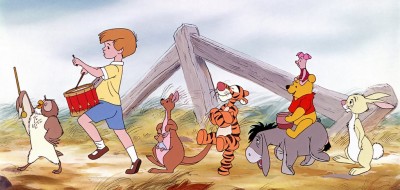
Academy voting time
- This past week was a relatively quiet one. I’ve been spending more and more of my time going to screenings for the Academy. Not only are there normal screenings at the AMPAS NY center (usually, at this time of the year, on Tuesdays and Thursdays), but there are also invited screenings. The Academy screenings have started to increase in that there are two films a night, and it gets to feel a bit like overload. I try to spread it out somewhat so that I avoid two films in one night by going to see some of the films at the invited screenings. Often present at these screenings are some of the celebrities from the films.
On Tuesday I saw the Lars Van Triers film, Melancholia – which droned on for four hours (or maybe it was just really 2’15″), and Thursday there was J. Edgar, the Clint Eastwood film with Leonardo DiCaprio. (2 hours 17 mins.) Definitely acting Oscar nominations in both films; both films had problems.
Starting next week the Animated Features begin screening. I have the DVD for Winnie the Pooh, but I’ve been trying to hold off seeing it until it’s on a big screen. As a matter of fact, that’s what I try to do with all the films, no matter how small. I try to see them all properly projected to be able to vote for them fairly. As for the feature animation, this is the first year the NY members are able to vote for the nominees in this category, so it’s something I’ll take seriously. That means I’ll have to sit through Hoodwinked 2 and The Smurfs in a theatrical setting (god help me). I do look forward to Winnie the Pooh, as I’ve said, as well as Cat In Paris on the big screen. (What can I say; I’m a 2D kinda guy.) After the theatrical screening, I’ll probably look at the DVD of W the Pooh a bit more closely.
Nest week, Between Sunday and Wednesday, there’s My Week with Marilyn, The Descendants as well as Rampart. There’s Puss In Boots and Tin Tin. To top it off, on Monday there’s a special screening dedicated to the work of Saul Bass – not Oscar related. It all starts to add up. But I’m not complaining; I actually love it and feel privileged to be able to take part in the process.
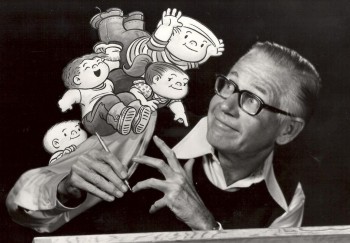 - I was saddened to learn of the death of Bill Keane, the cartoonist who created Family Circus in 1960. He was also the father of Disney animation director, Glen Keane.
- I was saddened to learn of the death of Bill Keane, the cartoonist who created Family Circus in 1960. He was also the father of Disney animation director, Glen Keane.
I was not the biggest fan of this comic strip when I was young. However, there was the Family Circus Christmas that aired one year. I thought it had one of the best stories ever done for a Christmas Special, and it gave me a new outlook on the strip. That show was directed by Al Kouzel in 1979 (Glen was one of the animators on the show). The animation isn’t very good, but the show reached out to me back then.
As a tiny tribute to Bill Keane, I’m posting this four page piece from Cartoonist Profiles, Dec. 1980 issue. It’s an edited transcript of an interview done with Bill on the Larry King Show.
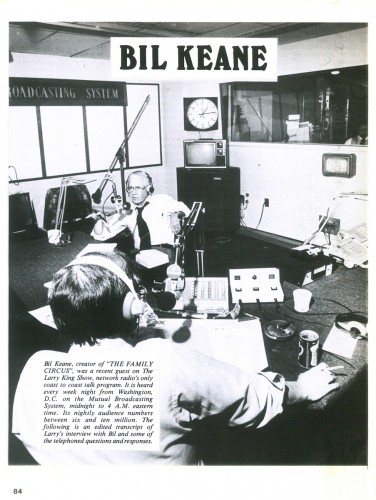 1
1Click any image to enlarge.
_____________________________
- I received this note a few days ago:
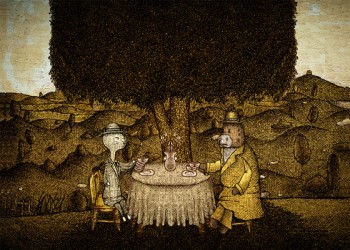 My name is John Kassab, and I was the sound designer on the Oscar winning short animated film, ‘The Lost Thing‘.
My name is John Kassab, and I was the sound designer on the Oscar winning short animated film, ‘The Lost Thing‘.
I am currently producing a wonderful animated short called ‘Cabbit‘ by emerging artist Soogie.
We are in the process of raising awareness about our Kickstarter fundraiser and wondering if you would like to check it out: here.
This is a little interview i did this week about the sound design: here.
… but we would love to get more attention for Soogie, our illustrator / writer / director / animator.
I don’t like to post Kickstarter events on this blog, so please don’t tell me about yours up and coming. There are too many films trying to raise money for me to be promoting any of them. I have my own films wanting funds and rarely mention them here. This film seems to want the funds primarily for post production.
- Bill Benzon has been writing in depth about Fantasia. On his blog, New Savannah, he’s been detailing the artistic and intellectual struggles visible in the film. Finally, he’s reached the last of the segments, the Pastoral, and he’s uncovered the sexuality just below the film’s surface. Bill writes:
- I saw the sexual undertones way back when. But it wasn¹t until I started taking frame grabs‹the last thing before I actually start writing‹that I noticed that all the thunderbolts are directed at Bacchus. And once I saw that, well, the fact that the last one exploded the vat full of grape juice . . . well, you¹ll have to read the post to see what I make of that.
He also posts that he’s going to put all of the eight segments together as a PDF. When he does that, I’ll let you know.
- Stephen Worth has started the Animation Resources blog. It’s a new place to check daily on your blog rounds. This is a way for Stephen to rekindle all the great posts from the old ASIFA Hollywood Animation Archive blog and for him to add some great new material. There was just too much good material there to let it pass on. You’ll notice it’s part of my blogroll to the right.
Bill Peckmann &Comic Art &Daily post 11 Nov 2011 07:02 am
Harvey and Jack – Part 6
- Today is Veteran’s Day, and what a way to celebrate than to let Harvey Kurtzman and Jack Davis supply us with a few good War Stories. To that end, Bill Peckmann contributes #6 in this series of a collaboration between the two. Over to Bill:
- Here is the first Harvey Kurtzman cover for his very ambitious “Civil War” series that was supposed to run in EC’s FRONTLINE COMBAT and TWO-FISTED TALES titles. In 1952, Harvey’s creative juices knew no bounds, this war series debuted just before MAD No. 1 came out some months later. As kids in those days, way before there was colored TV with the History Cable Channel, we were very lucky to have Harvey at the helm of his war comics to give us a slice of history that wasn’t as dry or dusty as it seemed to be in our school books. The series was to run seven issues to cover the whole Civil War. Sadly, only three issues were completed before both FRONTLINE and TWO-FISTED titles folded.
Just as Jack Davis did the very first story in MAD No. 1, he also did the first story in the first “Civil War” issue. Jack was a great opening act, what better way to get someone to buy the comic book than to see his first page, splash page, grabber.
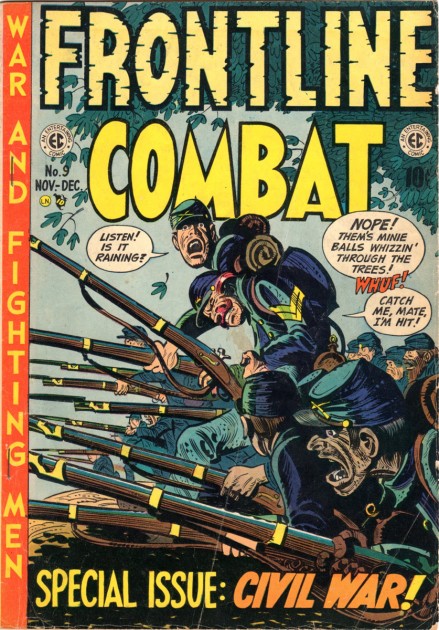
Magazine Cover
.
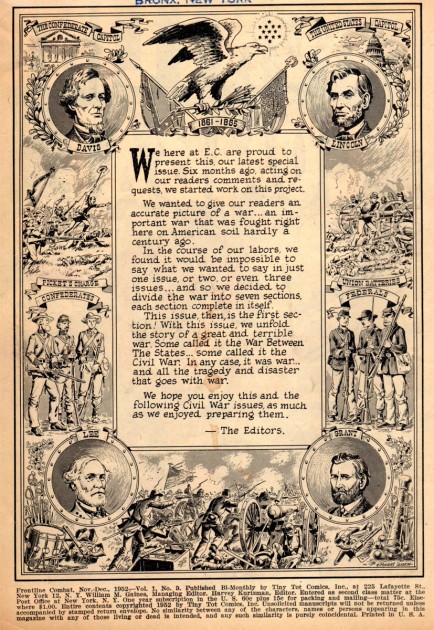 1
1Intro art by John Severin. His love for the subject matter shows!
.
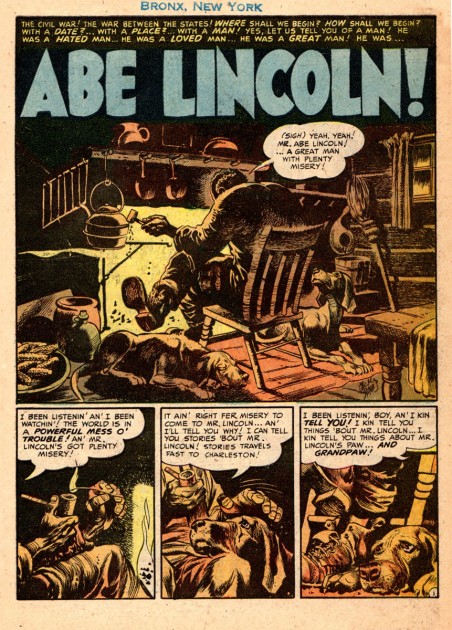 2
2.
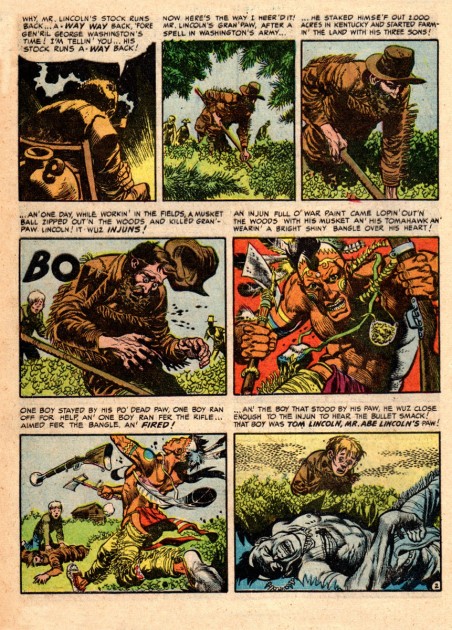 3
3hite”>.
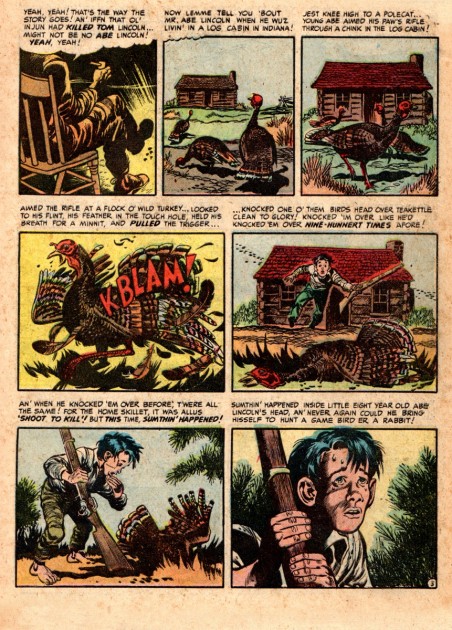 4
4.
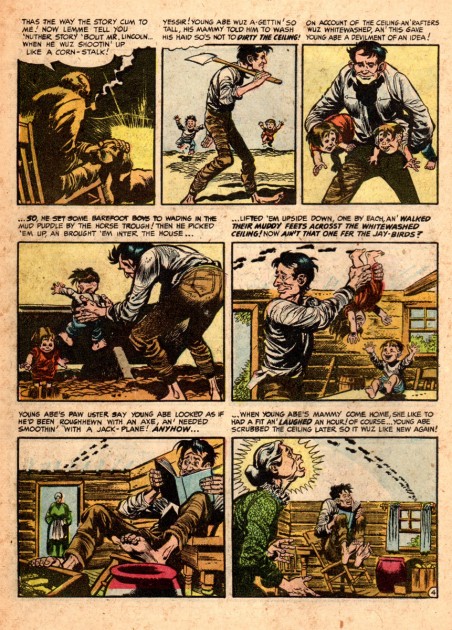 5
5.
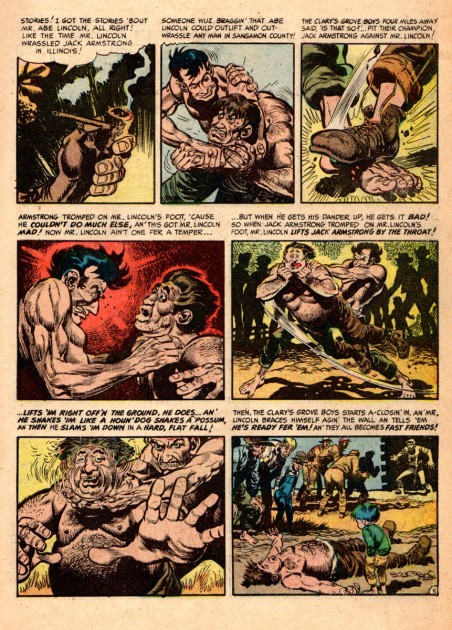 6
6.
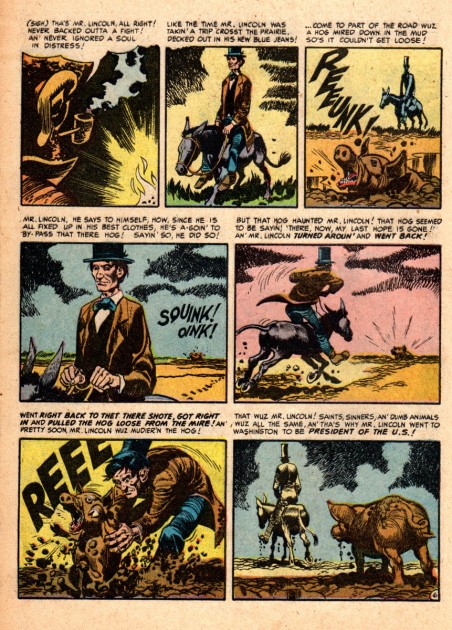 7
7.
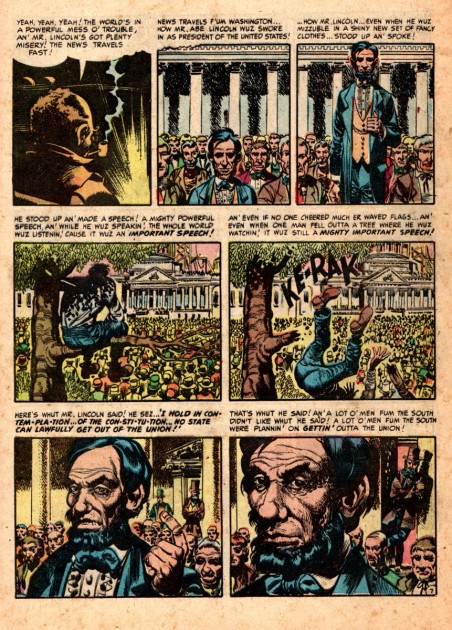 8
8.
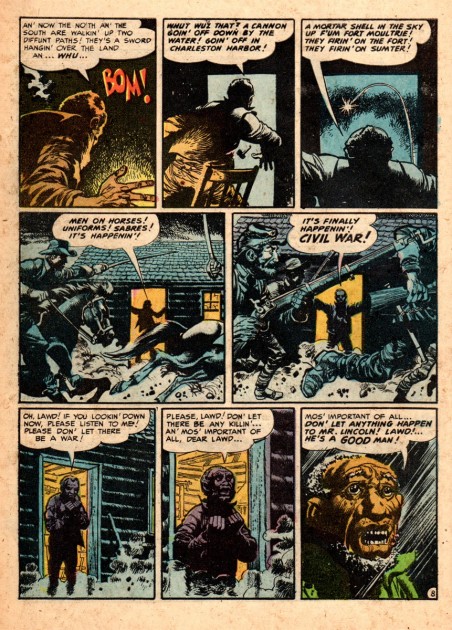 9
9.
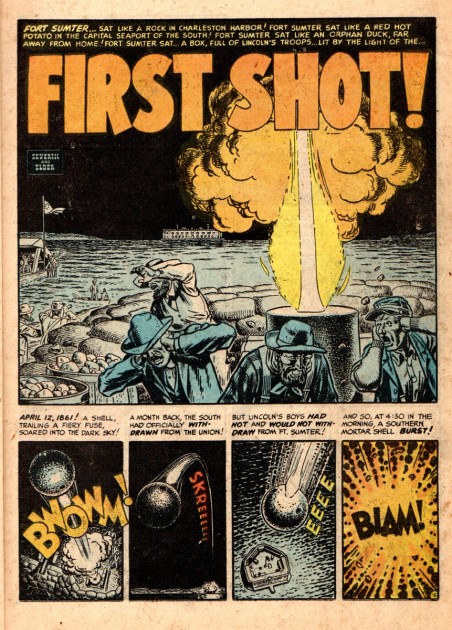 10
10The first Davis story also flows perfectly into the second Severin and
Elder story. The terrific art is done by John Severin (penciler) and
Bill Elder (inker). As with Jack Davis, the strength of Kurtzman’s writing
and rough laying out comes roaring through.
Kudos again to Marie Severin’s coloring!
.
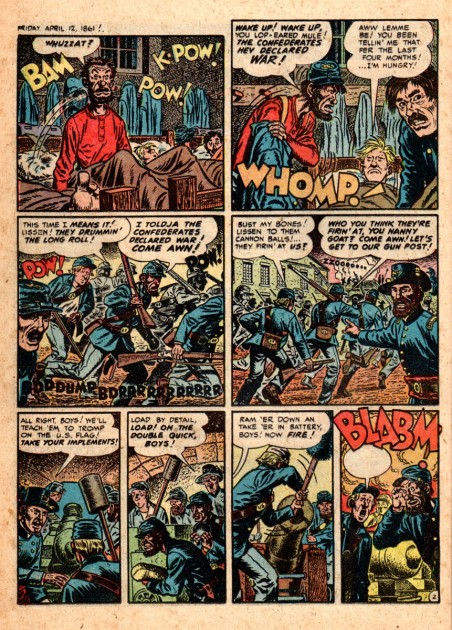 11
11.
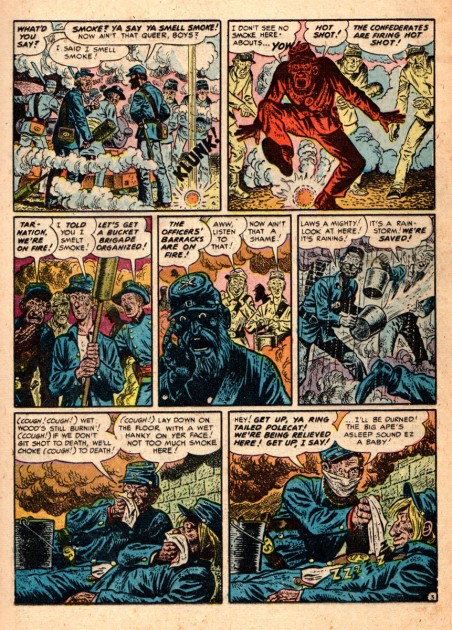 12
12.
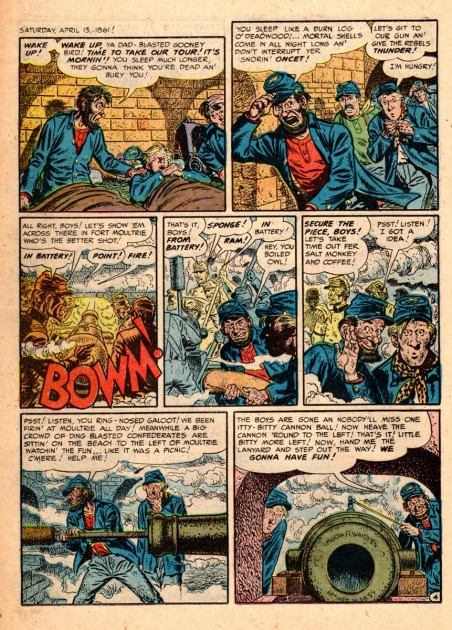 13
13.
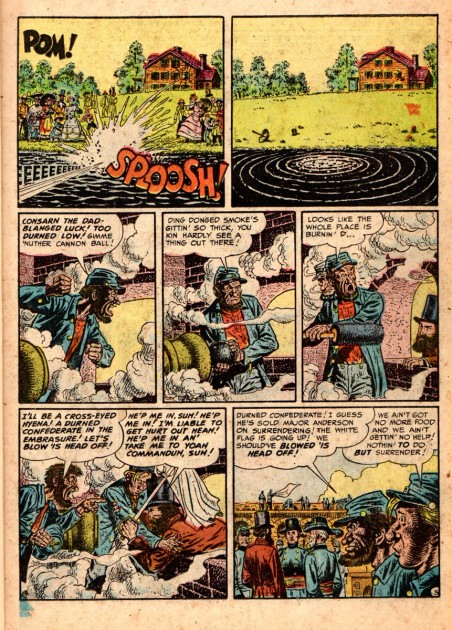 14
14.
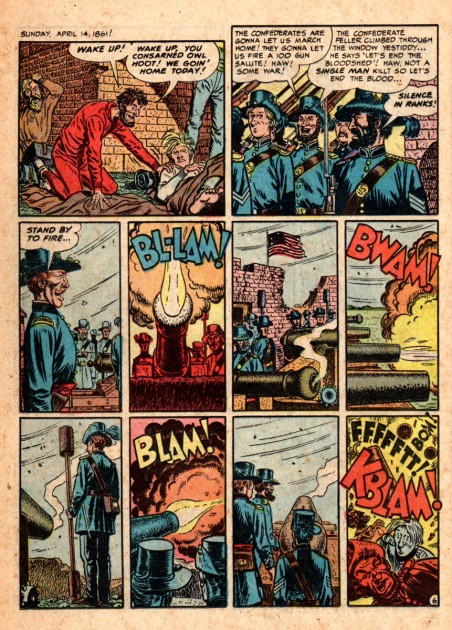 15
15.
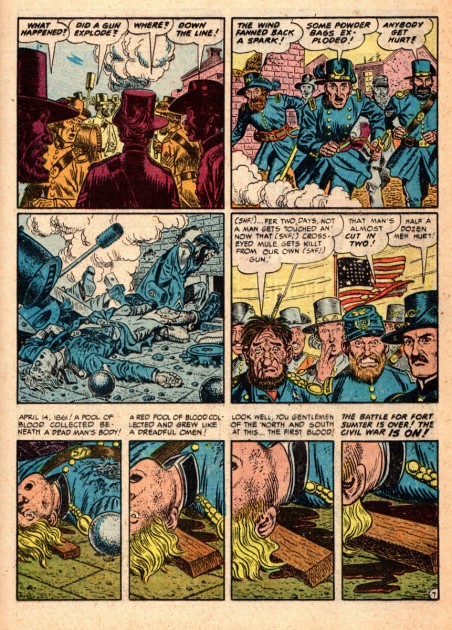 16
16.
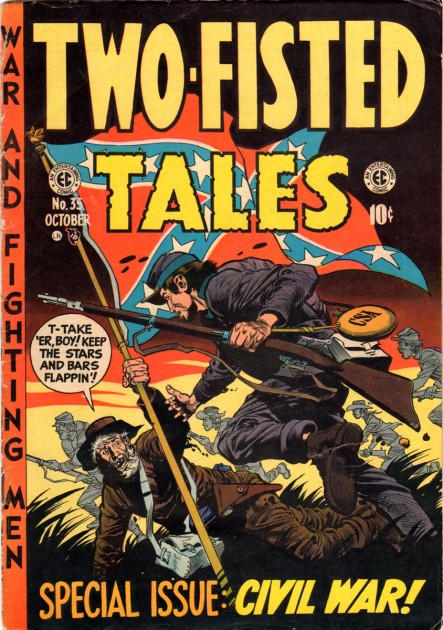
Here’s Jack’s cover for the third and last issue of Harvey’s “Civil War” series.
It was TWO-FISTED TALES No. 35. A little more than a year and a half after
it had started, the planned seven issue series was over and never completed.
(Us old EC fans always dreamt of what those last four issues would have looked like.)
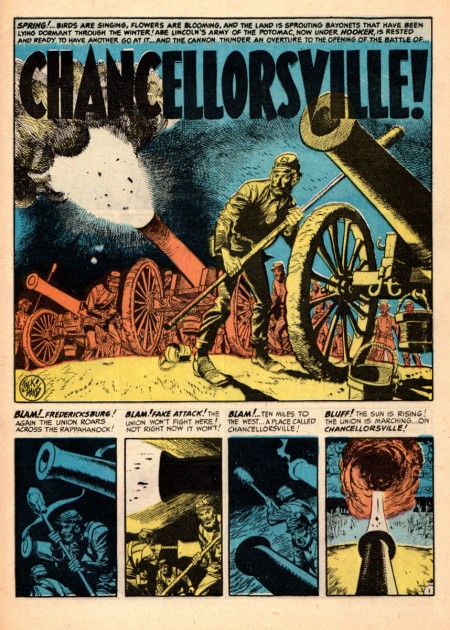 17
17
This is Jack’s rendering of the battle of “Chancellorsville”. It’s the last story in the
last issue of the “Civil War”series. Quite a visual high point for everyone working on it,
especially the dramatic coloring.
It’s a bit ironic that in the last panel, of the last story, of the last issue in the series,
that Harvey would miss one of the very few typos that ever graced his books.
“1893″ should read “1863″, go figure…
Many thanks to Bill Peckmann for sharing this artwork with us.
